|

The authors’ text may be used for any scholarly
or
educational purpose without prior permission
so long as this website is cited.
CONTENTS
――――♦――――
|

|
THE
RAILWAY COMES TO
TRING:
The London & Birmingham Railway 1835-1846
FOREWORD
“. . . . the inhabitants are making
every exertion to accommodate the public that every day throng this
beautiful neighbourhood, which, from the variety of hill and dale,
wood and water, combined with the extensive views it commands, is
likely to become a place of importance.”
The opening of the
railway from Euston to Tring, The Bucks Gazette, October 1837.
We doubt that many, if indeed any of the travellers
that pass through Tring Station spare a thought for its history. Why should they? With the possible exception of
the adjacent
Royal Hotel the station offers nothing that is likely
to arouse historical curiosity. Austere functionality now pervades
the scene. As for the railway today, it bears little resemblance
to that constructed by Robert Stephenson and his team of civil
engineers with their contractors and gangs of navvies.
The following account makes no claim to be a detailed
treatise on the history of the London and Birmingham Railway.*
It aims instead to provide readers interested in the history of
the town with a résumé of events leading up to the Railway’s
arrival at Tring in October 1837, to the construction of the
town’s station, and some points of general interest concerning travel
in the locality in that age. Our narrative is in the form of a compilation of
notes and historical extracts taken from the sources listed at the
end of this booklet. We would be interested to hear from
anyone who can add further information on the history of the
London and Birmingham Railway in the locality.
Our thanks go to Michael Bass, Chris Reynolds, John Savage
and Russell Burridge, and to staff at the Buckinghamshire Centre for Local Studies and the Hertfordshire Record Office for their
kind assistance.
Ian Petticrew and Wendy Austin,
November 2013.
* For a
more detailed account of the Railway’s history see . . . .
The Train Now Departing.
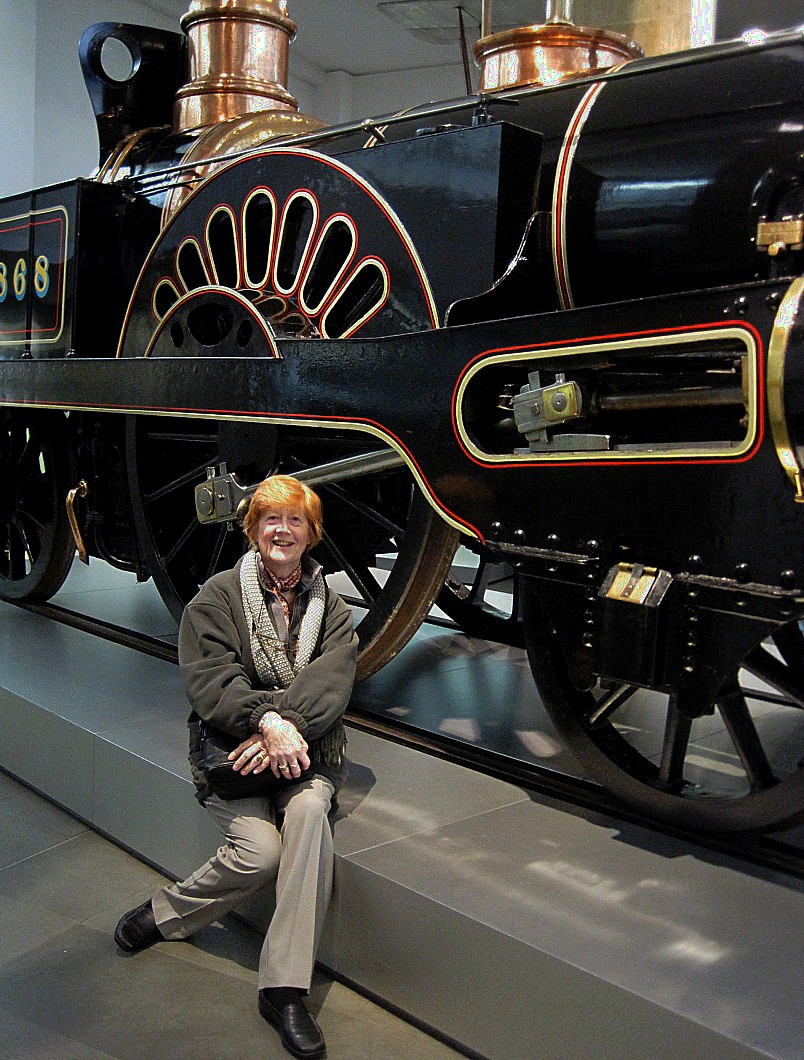
――――♦――――
THE RAILWAY ACT IS PASSED
“The Bill for the new London & Birmingham
railroad has at last passed through both Houses of Parliament. For
nearly three years since the original scheme was first drawn up, the
struggle has gone on. The greatest opposition has come from the
large landowners of Hertfordshire, viz. Lord Essex, Lord Clarendon,
Lady Bridgewater, Sir Astley Cooper and others.
In deference to the wishes of these
landowners, big alterations were made in the original route. The
terminus is changed from King’s Cross to Euston, and at Watford the
line is altered to avoid the parks of Lords Essex and Lord
Clarendon, and this will involve the construction of a very long
tunnel at Watford. The original plan was to carry the line along the
Great Gaddesden valley, but this was abandoned, owing to the great
opposition from the House of Ashridge. Those who stood in the way of
progress were eventually won over by giving them tremendous prices
for their land, in some cases three or four times its value. The
total cost of carrying the Bill through Parliament amounted to
nearly £73,000. The difficulties with the various landowners
appeared to be insuperable, but they appear to be over now, and in a
few years the railway will be an accomplished fact.”
Tring’s Vestry
Minutes, 1833.
|
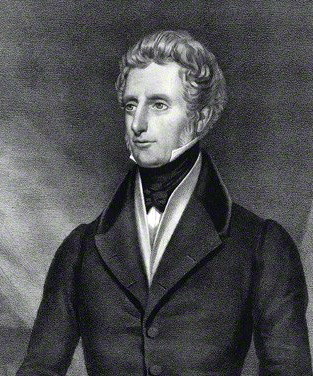 |
|
Railway opponent, John Cust,
1st Earl Brownlow (1779-1853). |
The London and Birmingham Railway Company
required the authority of a ‘private’ Act of Parliament before
construction of the line
could begin. Among the privileges that
such an Act conferred on the Company was that of compulsory purchase,
the ability to buy land without the owner’s consent, but at a fair valuation. However,
influential landowners who did not wish to sell could oppose the
Company’s railway Bill as it passed through Parliament, and they
did.
It is not easy to ascertain what the Company thought was a fair
price for land in Hertfordshire. They estimated £183 per acre
for land between Kilburn and Tring, and £71 per acre between Tring
and Wolverton. However, the surveyors generally reckoned a
reasonable price for agricultural land at that time to be £70 per
acre. The Bridgewater Trustees received £76 per acre for land
in Tring, Marsworth and Cheddington, and their tenant, Peter
Parrott, £3.60 per acre, giving a total of nearly £80 per acre; and
for 43 acres of land in Northchurch, Tring, Cheddington, Marsworth
and Horton, they received £130 per acre. They also received
the expenses they incurred in opposing the 1832 London and
Birmingham Railway Bill, a sum amounting to £2,178. Mr.
William Smart of Aldbury was paid £140 an acre and Captain Harcourt
of Tring £120. Members of Tring Vestry appear to have
considered the amounts awarded to these objectors to the railway
scheme to be ‘tremendous’, but several other landowners did accept
the railway company’s original valuation.
|
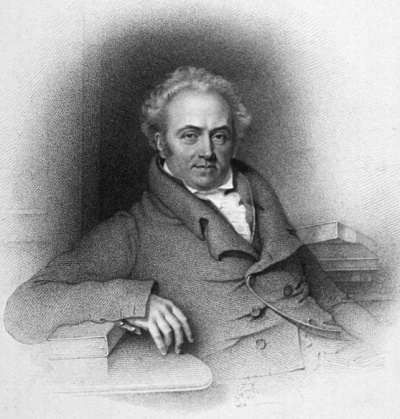 |
|
Railway
opponent, Sir Astley Cooper Bt. (1768-1841). |
The Company first applied to Parliament for a
private Act in 1832. Their Bill passed through the House of
Commons, but was vetoed in the Lords by an influential landowner,
Lord Brownlow of Ashridge, who, speaking on behalf of a group of
railway objectors, stated:
|
“That the case for the promoting of the Bill
having been concluded, it does not appear to the committee that they
have made out such a case as would warrant the forcing of the
proposed railway through the land and property of so great a
proportion of dissentient landowners and proprietors.”
The London and Birmingham Railway,
Roscoe and Lecount (1839).
|
The Bill’s failure resulted in the Company wasting Parliamentary and
other expenses amounting to £72,869, a huge sum for the time, and it
caused outrage. In order to placate influential landowners who
remained unwilling to sell – and thus avoid further opposition when
their railway Bill again came before Parliament – the Company was
obliged to pay them considerably above market rates. But when
a further application was made to Parliament in the following year –
a significant number of objectors’ palms having been greased in this
way during the intervening period – the railway Bill went through
almost unopposed and passed into law on the 6th May, 1833.
Work could then commence, although the volume of detailed planning,
the preparation of drawings and specifications, and the letting of
construction contracts by competitive tender was a lengthy task, and
it was to be a further 12 months before the first sod was turned.
By the end of 1838, when the line eventually opened, the Company had
paid out £537,596 for land against their initial estimate of
£250,000.
――――♦――――
ROBERT
STEPHENSON
CIVIL ENGINEER
(1803-1859)
The great railway cutting at Tring is just one of a number of
notable civil engineering features along the course of the London
and Birmingham Railway. Completed almost 180 years ago, it is almost
60 feet deep in places and, at 2½-miles, is the longest cutting on
the line. It took 500 men three years to excavate using picks,
shovels and wheelbarrows, and helped along by horse power. In that time they cut through 1,400,000
cubic yards of chalk, which they then had to lift to the surface for
disposal. This feat of pre-Victorian civil engineering was planned
and carried out under the supervision of Robert Stephenson.
|
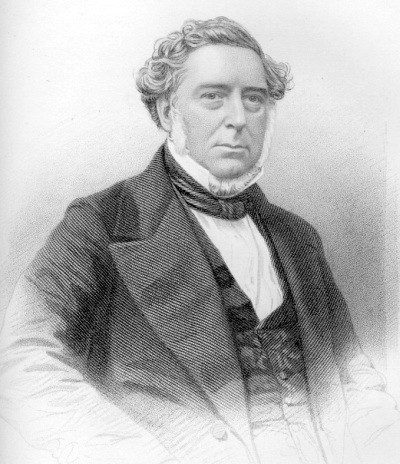 |
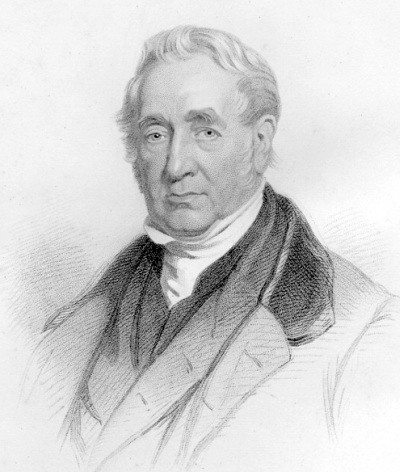 |
|
Robert and George Stephenson. |
|
Robert Stephenson was born near Newcastle-upon-Tyne, the only son of
George and his wife Fanny. His mother died when he was two years old
and Robert was then cared for by his father’s sister and
housekeeper. George Stephenson (1781-1848), a self-made man of scant
formal education, was a tough and ambitious father who was
determined that his son followed in his footsteps. Robert received a
good education including a short period spent at Edinburgh
University, to which was added intensive engineering training. He
soon became his father’s assistant, eventually working with him on
projects such as the construction of the Stockton and Darlington
Railway. Following a 3-year mining venture in South America, Robert
returned to England in time to oversee construction of the Rocket
― the locomotive that in 1829 won the famous Rainhill Trials ― in
the process creating the basic locomotive design template for the
remainder of the steam traction era.
In 1830, the London and Birmingham Railway Company was formed and
the civil engineering firm of George Stephenson & Son was appointed
to make surveys, select the best route and carry the railway through
the arduous process of obtaining a private Act of Parliament. Two outline
surveys had already been made; one, via Quainton and Banbury, by
John Rennie Jnr., the other, via Rugby and Coventry, by Francis
Giles. Following a detailed examination of the ground, and with some
alterations, the Stephensons recommended the route via Rugby and
Coventry. This being approved by the Board, from then on George disappeared
from the scene leaving Robert
to take over the detailed surveying and planning of the line. Here, he had to tread
a delicate path to avoid upsetting more of the landed gentry than
necessary, for this was an age in which they held very considerable
influence and the line would inevitably cross some of their estates.
Stephenson’s preferred choice of route for taking the railway over
the Chiltern Hills was along the Gade Valley from Two Waters,
through Hemel Hempstead, Gaddesden and Dagnal and then on to
Leighton Buzzard. This route crossed land owned by, among others,
the influential Earl of Essex and the trustees of the Bridgewater
estate, and it aroused such opposition that the Company was forced
to find an alternative. Stephenson’s second choice was to follow the
Bulbourne Valley through Berkhamsted and to the east of Tring. However, taking the railway through the Tring Gap required the
construction of a long and deep cutting to enable the railway’s
maximum gradient to fall within Stephenson’s target of 1:330 (16
feet to the mile). |
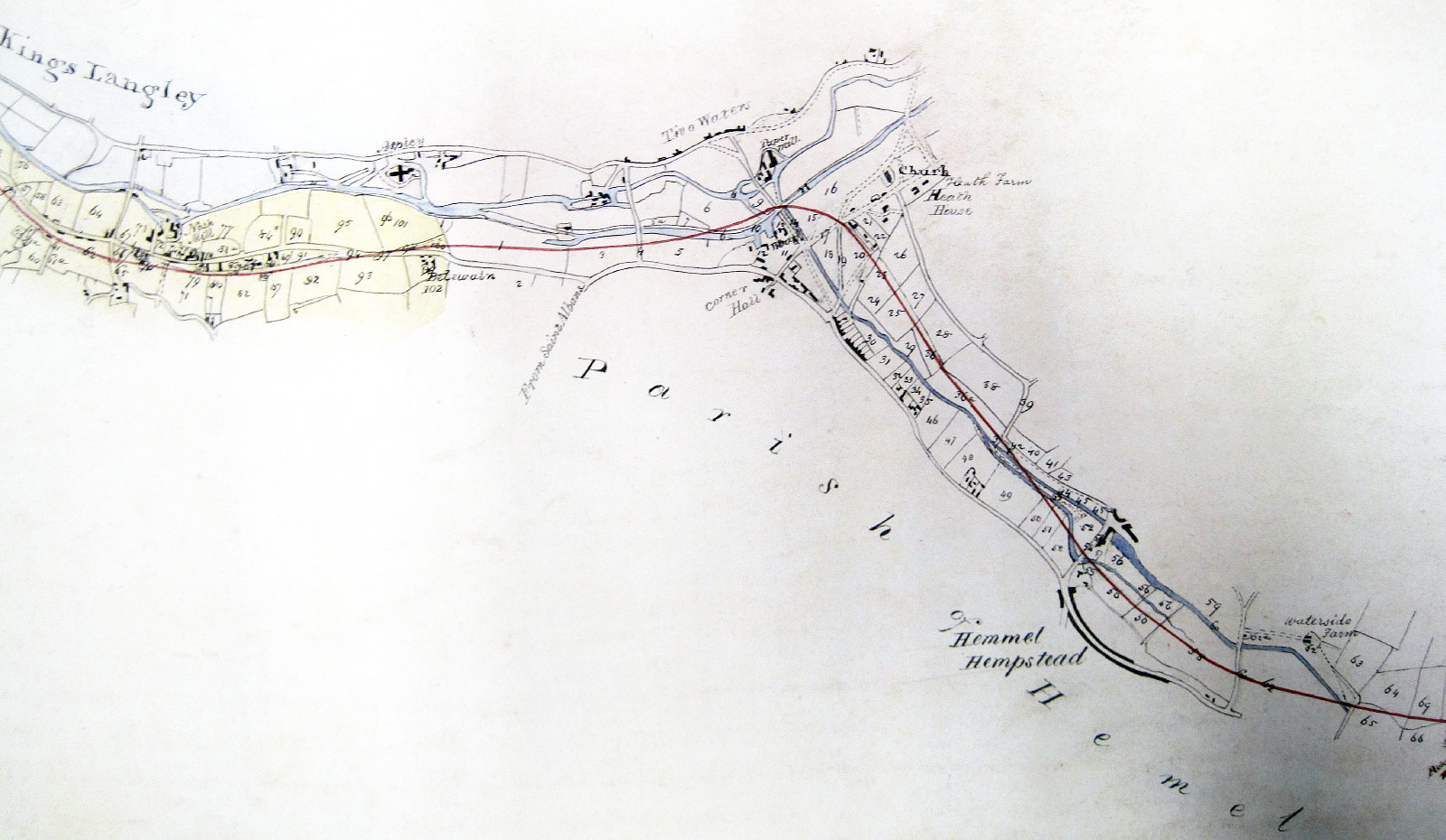
|
Part of the plan of
Stephenson’s abandoned route in Dacorum. At Two
Waters, the line
was to have turned into the Gade Valley, passing
through Hemel Hempstead and
crossing the ridge of the Chilterns through the
Dagnal Gap. |
Having obtained their Act of Parliament, the Company appointed
Robert Stephenson Engineer-in-Chief at an annual salary of £1,500
(later increased to £2,000 to equal that paid to Brunel, then
building the Great Western Railway). Stephenson’s contract required
him to devote virtually all his time to this exceptionally large and
complex undertaking, during which, it is said, he walked the entire
route 20 times. All manner of civil engineering difficulties had to
be overcome requiring the construction of cuttings, embankments,
viaducts, bridges (including difficult masonry ‘skew arch bridges’
that cross roads and waterways at an angle), cuttings (including
two substantial cuttings at Tring and Blisworth) and tunnels, of
which that at Kilsby in Northamptonshire is generally considered to
be one of the most ambitious civil engineering feats of its age.
Robert Stephenson’s gifts of leadership and organisation were
needed during the difficult task of selecting and managing his
project team, which eventually numbered sixty. He was supported by
five assistant engineers, under whom were a team of sub-assistants,
draftsmen and pupils (in effect, apprentices). The young men
referred to themselves as ‘Stephensonites’ and remained loyal to
their chief in later controversies and triumphs. A contemporary pen
portrait tells us that Stephenson had “an energetic countenance,
frank bearing, and falcon-like glance . . . . he was kind and
considerate to his subordinates, but was not without occasional
outbursts of fierce northern passion.” But the intense pressure
of the work took its toll, for the account continues “during the
construction of the line, his anxiety was so great as to lead him to
frequent recourse to the fatal aid of calomel”, a toxic
mercury-based chemical prescribed by English doctors at the time as
a universal remedy.
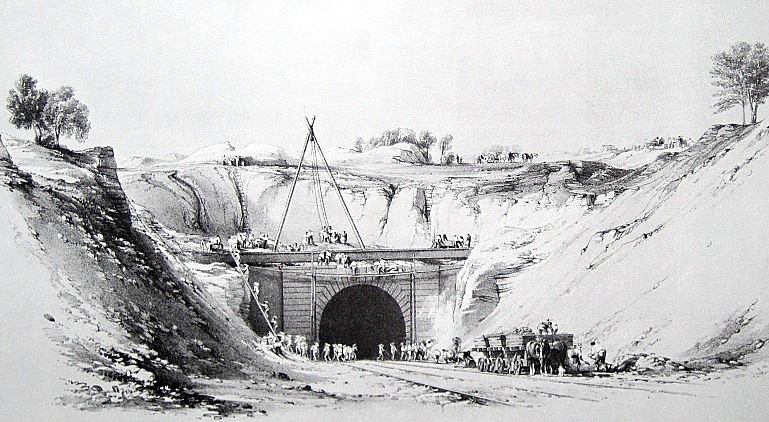
Watford Tunnel under construction, June 1837,
by John Cooke Bourne.
The railway opened in stages as work progressed; to Boxmoor, on the
20th July 1837; to Tring, on the 16th October; to Denbigh Hall, and
to Rugby from the opposite direction, on the 9th April (the 38-mile
gap being bridged by a shuttle coach service); and
the line was opened throughout on the 17th September, 1838. In the
meantime the Grand Junction Railway ― constructed, principally, by
another famous civil engineer, Joseph Locke ― had reached Birmingham from
Warrington, both railways sharing the same terminus at Curzon
Street. There was now a continuous rail link between London and the
North-West of England.
Following the line’s completion, Stephenson’s career went from
strength to strength. Among his engineering triumphs was the High
Level Bridge across the Tyne (1849), the great Britannia Bridge
across the Menai Straits (1850), and the 6,588-feet long Victoria
Bridge over the St. Lawrence River at Montreal in Canada (1859). But
the Dee Bridge on the Chester to Holyhead Railway was to cast a dark
shadow over his later achievements, for on the 24th May, 1847, it
collapsed while a train was crossing, causing in five deaths and
nine serious injuries.
|
 |
|
Entrance
to Watford Tunnel.
An L&NWR postcard. |
After 1840, Stephenson was consulted increasingly on overseas
railways schemes and began to travel a good deal. He also became
engaged in public activities and in the development of his own
business concerns, particularly the locomotive manufacturing firm of
Robert Stephenson and Company based in Newcastle-upon-Tyne. In
1847, he broadened his interests further when he entered Parliament as the member for Whitby, a seat he held
until his death. In politics, Stephenson was a Tory of the Right, hostile to
free trade and anxious to avoid change in almost any form, which
seems paradoxical in a man who was responsible for a great deal of
economic and social upheaval.
In 1842, Stephenson was again concerned with matters at Tring when
he was consulted by the London, Westminster & Metropolitan Water
Company on the feasibility of providing London with water from
sources in the Chiltern Hills. His reports were lengthy and, as to
be expected, well-reasoned. He stated “I am well acquainted with
the chalk district between Watford and Tring, and it having devolved
upon me, in the course of my connexion with the London & Birmingham
Railway, to sink a great number of wells, my attention has been
particularly called to the extraordinary quantity of water existing
in the chalk . . . .” Perhaps fortunately for our locality,
the water company did not pursue the idea of using the Bulbourne
Valley to supply London.
In later life, Stephenson acquired all the outward marks of
recognition of a distinguished career. He declined a knighthood, as
had his father, but was elected a Fellow of the Royal Society and
served as President of both the professional bodies with which he
was associated, the Institutions of Mechanical and of Civil
Engineers. With his life’s work completed and the premature death of
his wife, he became melancholy, sometimes peevish, and he often
returned to visit his childhood haunts in the Northeast. His
constitution, never robust, finally gave way, and Stephenson died on
the 12th October 1859, aged 55 (Brunel had died a few weeks
previously, aged 53). There was never any doubt about Stephenson’s
burial place and 3,000 people packed Westminster Abbey for his
funeral. The driver of the first engine used on the London and
Birmingham line wrote to ask for a ticket – it is pleasant to record
that he received one.
|
 |
|
“Please to inspect 1000 Black
Beech Sleepers and let then be forwarded to
Tring”
R.
Stephenson. |
Robert Stephenson built the London and Birmingham Railway in
accordance with his father’s strict engineering principles as
evidenced by the line’s gentle curves and gradients, both of which
are conducive to high-speed running. All those who travel through
Euston Station and who walk out onto its forecourt can see a fine
bronze statue of Robert Stephenson (below) – and those few
travellers who do not hurry past with heads down might pause for a
moment or two before it to pay their respects to his memory.
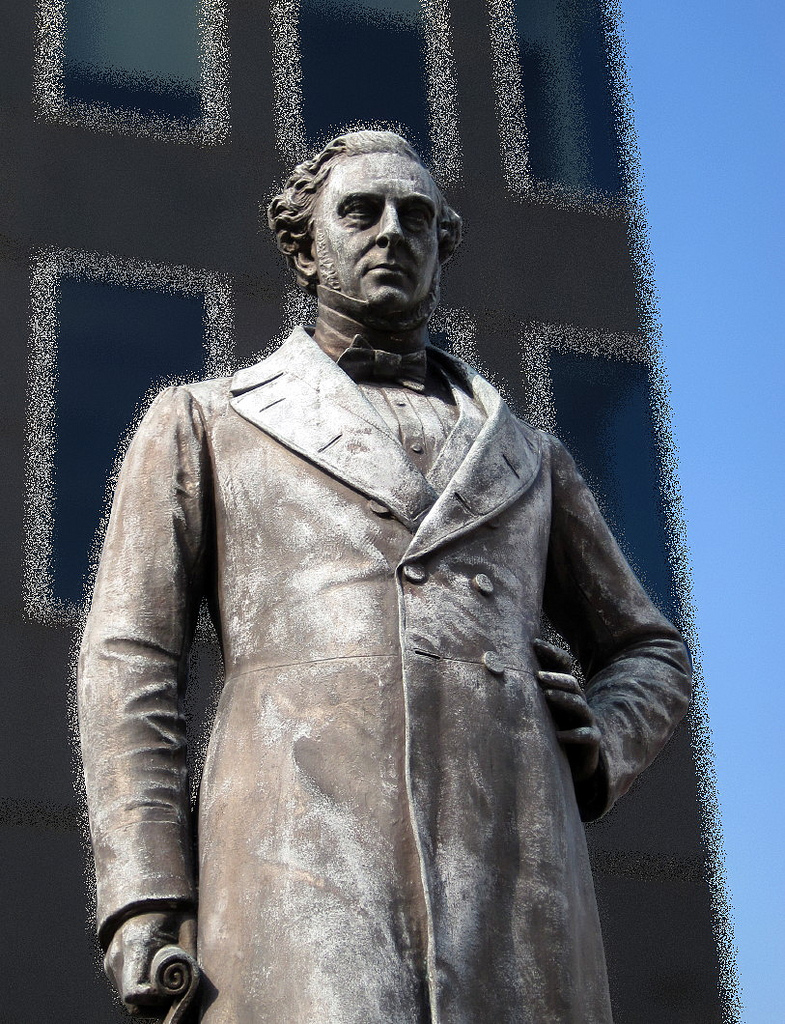
Robert Stephenson, FRS, Civil Engineer:
Statue (1871) by Carlo Marachetti, Euston
Station.
――――♦――――
|

Euston to
Birmingham gradient profile.
At Birmingham, the line originally terminated at Curzon
Street, about three quarters of a mile north-east of New Street Station.
|
ARTHUR MACDONALD (BROWN) M.A.
(1861-1951)
The following notes relating to the railway at Tring were written by
Arthur MacDonald Brown (usually known as Arthur MacDonald) some time
during the late Victorian era. They were intended to form a section
of a published book on the complete history of the town, and it is
apparent that he put much time and effort into its research.
However, although some sections are detailed, others comprise rough
notes that were probably awaiting further research before
being written up.
|
 |
|
Arthur Macdonald (Brown). |
Much to the regret of today’s local historians the book was
never completed, for as MacDonald said, “I have quailed at the task
of putting them [the notes] into proper shape for a
parish history, but have amused myself in old age by utilizing some
of them in a gossiping narrative.” In 1940, he did just that
when he published a small book entitled That Tring Air to
help raise funds for the Tring Nursing Association.
This transcription of MacDonald’s section on the railway is taken
from his original writing and, apart from some editorial notes [bracketed
in italics], the extracts appear exactly as he wrote them. In
some places they contain their author’s quaint Victorian turn of
phrase, in others his rather anecdotal style. It may well be that
modern research and the findings of later writers and railway
historians call into question some of the facts and information, but
in essence the story of the coming of the railway to Tring remains
unaltered. Although his image (enhanced by a typically late
Victorian heavy moustache) suggests a serious gentleman, it probably
belies a more light-hearted character, for he also wrote a number of
humorous poems, songs and sporting ditties.
Arthur MacDonald was the second son of William Brown, a land agent
of Tring, who founded the local firm of estate agents, Brown & Merry. After attending Berkhamsted School and Jesus College, Cambridge, he
became a partner in the family firm in which he fulfilled a
distinguished career. He was an expert in ecclesiastical and lay
tithes, as well as in estate management, also undertaking the role
of Examiner in Surveying for the Civil Service.
TRING RAILWAY:
Notes written by Arthur MacDonald (Brown) c.1890.
In October 1837 the London & Birmingham Railway, now the London
& North-Western, was opened to Tring. Two companies were formed in
1830 to form lines from London to Birmingham; one by Oxford and
Banbury, the other by Coventry. They amalgamated and on George
Stephenson’s advice chose the latter route. The first survey had
been made in 1825, but the commercial crisis of that year stopped
further progress. The final surveys were made in 1830 and 1831, and
Robert Stephenson is said to have walked over the ground no less
than 20 times in selecting the best route. Of course the engineering
difficulties were the lightest obstacles that had to be overcome. The opposition from all classes was almost overwhelming. The
surveyors had exciting times, and had often to adopt stratagems to
get their work done. In one case the owner was so determined in
keeping them off his land, and so vigilant in his determination,
that the necessary levels had to be taken in the middle of the
night, with a dark lantern held on the instrument and another to the
staff. Another Reverend owner had to be circumvented by being
watched safely into the pulpit, when the work was snatched. In not a
few cases it came to a pitched battle, and the invaders had to get
navvy protectors.
The Route – the direct route from Watford to Leighton would be
by way of Hemel Hempstead and the Little Gaddesden
and Dagnal valley, but we have to thank the powerful opposition of
the landowners in that district for turning the line out of its
course down the Berkhamsted valley and so by Tring. The opposition
to the line was by no means confined to the landed interest; public
meetings were held at many places, protesting against railways in
general on every conceivable plea. The tradesmen foresaw the loss of
all their business, those who lived within a mile or two of the line
expected their houses to be set on fire, the air was to be poisoned,
all horses were to emigrate, and all cattle were to be frightened to
death.
There is said to have been a public meeting held at Tring to protest
against a proposal to bring the line from New Ground to near Grove
turn, this being considered dangerously near. They changed their
tune when the line was being made, and wanted a branch, but the
opportunity had passed.
The Bill was thrown out by the House of Lords in 1832, seven-eighths
of the owners along the line being dissentient. It was brought in
again however and passed in 1833. The average cost of the land was
£6,300 per mile, which at one chain wide is equal to nearly £80 per
acre. The cost on other lines varied from £3,000 to £14,000 per
mile.
Robert Stephenson was appointed engineer-in-chief. The section from
Camden to Tring was completed first, Camden being originally
intended for the terminus. The Contractor for the section from Tring
to Leighton was named Townshend; he was one of the unfortunate
eleven out of the eighteen contractors who became bankrupt over the
business. Contracting on such a scale was new, and the ins and outs
of estimating were little known. There were no leviathan contractors
of the modern Lucas & Aird type
[an engineering company founded
in 1848 and trading until 1990].
The Tring Cutting – the largest on the line, is well known as a
stupendous engineering work, and nearly approaches the limit of
depth at which tunnelling becomes preferable. It passes through the flintless lower chalk ridge of Ivinghoe for nearly two miles and a
half. Its average depth is forty feet; for a quarter of a mile it is
57 feet; a million and a half cubic yards of chalk were removed when
it was first made, and they form an embankment to the north six
miles long and 30 feet high, besides huge spoil banks of superfluous
material.
The work was commenced at Pitstone end, and took nearly three years. The method of raising the chalk was peculiar and attended with no
little danger. 30 or 40 horse-runs were erected – steep inclines
made of three or four planks side by side wide enough for the legs
of a barrow to stand on, placed down the slope of the excavation. In
the field at the top was a strong post with a pulley upon it; over
this a horse drew a rope and chain which passed down the slope and
was hooked on to the barrow. When the barrow was full, the word was
given, the horse was trotted out into the field, the navvy hung to
the handles of the barrow and ran up the planks in an almost
horizontal position, taking his chance of a lump or two falling back
on him. Any irregularity in the motion of the horse, and down went
the man, barrow and all, and he had to be very quick to escape
falling under it. All the men were precipitated to the bottom many
times, but such is the toughness of the British navvy that there was
only one fatal accident. The engineer, seeing the great risk of the
method, invented a kind of lift consisting of a small tram on lines
carrying two barrows, but this the men disapproved of and broke,
preferring the old method to a labour-saving contrivance.
|
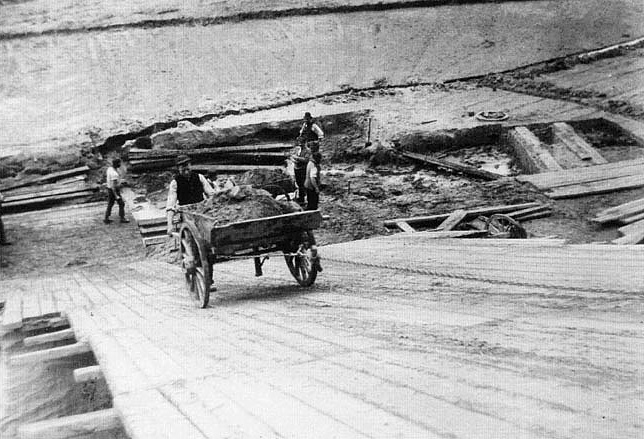 |
|
Horse (or barrow) run in use on
the Manchester Ship Canal. |
System of ‘ganging’
– the price per cubic yard paid to the men
varied with the depth from seven pence to a shilling, and the men
formed themselves into corresponding gangs of from seven to twelve,
each man thus taking a penny per yard raised by the gang. The
contractor found the horses and runs, the men undertaking to dig,
raise and deposit the chalk. One of each gang acted as ‘runners’,
and they could run 100 barrows in a hundred minutes up a 90 ft
plank. The ‘diggers’ too had their dangers. The practice was to
undermine a length of some yards, leaving one or two pillars of
chalk or ‘legs’ to hold it up, then to cut away the legs and by
driving piles into the top, bring down the overhanging mass. A
well-known old inhabitant of Tring, Bunce, was engaged in this work,
and was cutting away a ‘leg’ when the mass came down. He and his mate were buried in the falling chalk up to
their shoulders, but escaped without broken bones.
Townshend’s
[Thomas Townshend, 1771-1846, civil engineer and
contractor] section commenced about 200 yards north-west of
Tring Station; Cubitt [Sir William Cubitt, 1785-1861, founder of
W. & L. Cubitt, civil engineers] taking the nine-mile Kings
Langley to Tring section [according to company records,
the Cubitt contract terminated at the northern end of Northchurch
Tunnel, the short section between the Tunnel and Tring Cutting
(contract 6B) being let to Richard Parr]. The
bridge at Northfield has always gone by the name of the ‘bird-house
bridge’, from the circumstance of a Dwight from ‘the hills’, one of
the originators of the pheasant breeding business
[Matthew Dwight, game farmer], bringing a
hut on wheels or ‘bird-house’ down to that point, where he lived and
sold beer to the navvies.
The regular navvies or ‘old hands’ commenced the cutting, and
thought they could do it without assistance, but it was found
necessary to employ quite an equal number of local men when the work
got deeper, and they soon showed that they could hold their own with
the old hands, not only at digging, in which Tring men have always
excelled, and still do so, but at this (to them) new practice of
‘running’. This excited great jealously among the old hands, which
rankled in their minds long after, and on other works a Tring man
was in danger of getting his head punched if the others knew where
he came from.
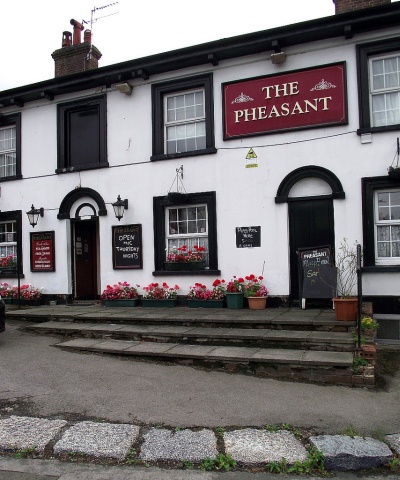
|
Former stone block
railway sleepers in use as boundary
markers at New Mill, Tring. The two
holes in the top of the block on the
right were to hold the oak peg fasteners
for the rail chair. The other blocks are
up-turned. More former sleeper blocks
are in use as coping stones on the
nearby canal at Cooks Wharf.
|
|
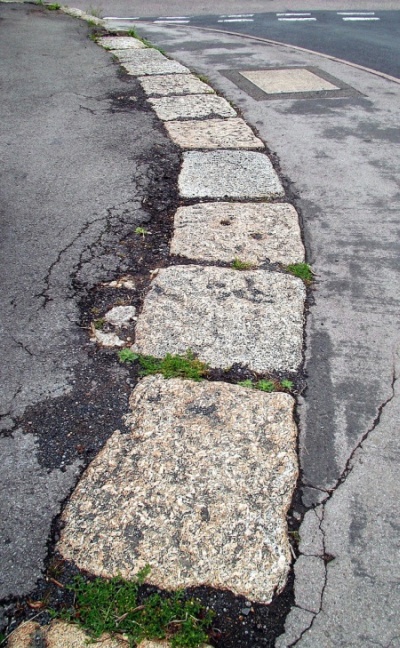 |
|
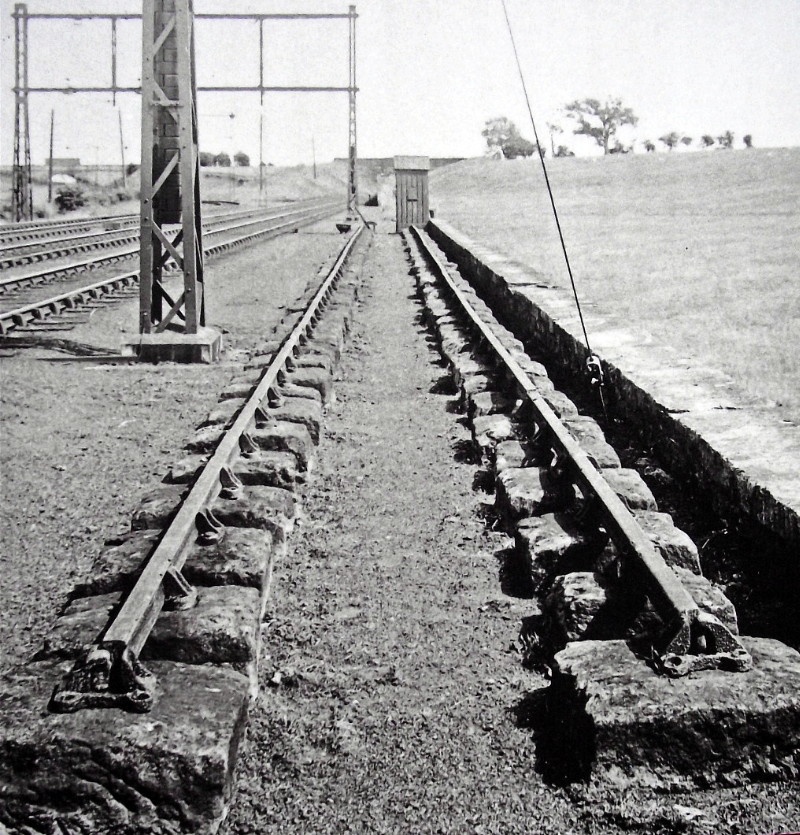 |
|
A section of line laid on stone
block sleepers. |
Altogether there were about 500 men employed in the cutting, and
they brought some life of a curious character into the
neighbourhood. Ivinghoe was Mr Townshend’s headquarters and pay
office, and many of the men lodged there and at the other villages
near the line. There was a lively party of eight at The Bell
in Tring, who occasionally gave some trouble to the authorities of
public order. Mr Bull and Mr Philbey were Parish Constables at that
time, and the former was called in on several occasions when the
navvies were having a row, when he laid about him with his staff of
office in a highly business-like and effectual manner. Mr Philbey,
too, had the faculty of arriving with great celerity on the scene of
action – he drove furiously a small pony cart and was familiarly but
irreverently called ‘Flying Issac’.
‘Tompkins at the Tommy Shop’ is an expression which denotes to every
man, woman and child in Tring and the villages round, an emporium
where almost everything can be obtained which makes life worth
living, from a loaf of bread to a lawn mower.
[Mary Tompkins &
Sons, according to a billhead of the time - Wholesale & Retail
Ironmongers, Coppersmiths, Braziers, Tin, Iron & Zinc Plate Workers,
Stove-grate & Range Manufacturers, trading at 51 & 52 High Street,
Tring, now the premises of F. W. Metcalfe & Son] This
establishment rose into prominence at the time of the construction
of the railway, being the rendezvous for the navvies to get their
‘Tommy’and also their tools. [The navvy knew that he was a
helpless being unless he could get his tommy – drink was ‘wet
tommy’; and this word came to mean all supplies – beef, bacon,
cheese, bread, butter, and tobacco.]
During the excavation many fossils were found, chiefly oysters,
nautili, ammonites etc. also numbers of concretions of iron pyrites,
popularly known as ‘thunder bolts’, some spherical and some
cylindrical, but most irregular and fantastic in shape, and all with
the common radiating structure.
At the Icknield road bridge 15 or 16 skeletons were found, and some
Roman pottery. Two urns were found at the Pitstone end, and these
are now said to be in the possession of the Antiquarian Society.
The line and bridges
– the lines were originally laid on square
stone blocks, instead of wooden sleepers. These were however
replaced throughout by timber on account of the excessive vibration,
and many of the old ‘railway blocks’ may be found forming useful
bases for shed posts, corner stones, mounting blocks for horsemen
etc. in the neighbourhood of the line.
[Some of these may still
be seen around the locality – notably at Hastoe Cross and in front
of The Pheasant public house in New Mill.]
Another replacement found necessary was the parapets of the road
bridges over the railway, which first consisted of open palisades of
short cast-iron doric pillars on stone bases. It was soon found that
horses passing over the bridges were terrified by the engines and
trains roaring below, in full view of the animals. These had to be
replaced everywhere by high, solid, brick walls. (I have not seen
the old palisades used up anywhere but as the front fence of my own
house, where they make a substantial, imposing, and everlasting
frontage-guard, the only drawback being their frequent use by the
passing boy as a dulcimer by drawing a stick along them, to the
detriment of the paint.)
The first locomotive
– the first locomotive was brought down in
pieces by canal, and housed in a barn at Pix Farm, beyond
Berkhamsted until wanted. It was a heavy 6-wheeled engine,
used to test and consolidate the line and was called the ‘Harvey Coombe’. There was great excitement to see this wonderful beast when it took
its first run down to Tring. One old wiseacre who had been working
at the cutting refused to go with the others to see it, remarking
that it was ‘Harvest home’ rather than ‘Harvey Coombe’,
meaning that it was the signal of their job being finished. This
ponderous joke, after a life of 50 years, is still repeated by the
survivors of that time with brimming hilarity.
Tring Station – it was the intention of the Company to place a
station at Pitstone Green at the north-west of the cutting, and
perhaps another at New Ground. The leading inhabitants of Tring,
however, finding their town about to be left out in the cold began
to agitate for a station at Pendley, but the owners of the Harcourt
estate had made such opposition to the line and asked such a high
price for the land, that the Company had taken as little of it as
possible. A public meeting was held at the Rose & Crown to
memorialize the Directors. Their reply was that if the land could be
obtained at a fair price they were quite willing to make the station
at the desired point, but that they were not going to pay a fancy
figure, and if the town wished it, they must get the land and if
necessary pay the difference.
Mr. John Brown of the Tring Brewery had noted this spot as not only
the nearest point to the town, but also as a convenient one for the
erection of a Hotel & Posting House; this gentleman not sharing the
opinions expressed by the coach proprietors, that horses, vehicles,
and roads would be of no further use after the arrival of railways.
On Sunday morning May 7 1837 the brothers John and William
[the
father of Arthur MacDonald, author of these notes] Brown set out
on a drive to Sunninghill, Berks, to interview Mr. Houghton, the
Agent for the Harcourt estate, with a view to applying a ‘lowering’
treatment. On arriving there, their foe had broken cover and they
started off again in pursuit to Ruislip. Here they received a
temporary check, but finally ran into him in the open ascending
Harrow Hill, after a rattling day with their old grey horse and
chaise. An appointment with Captain Harcourt was arranged, and
finally the two acres of land required were obtained for 300
guineas, instead of the thousand the price asked. Half an acre was
set apart for the station, and in the spring of 1838 The Harcourt
Arms now the Royal Hotel was commenced, under the
superintendence of Mr. Aitchison, the Railway Company’s architect,
and completed in March 1839. [George Aitchison, 1792-1881. After working on warehouse design he came into contact with some of
the directors of the L&B Railway, and devised a system of
book-keeping for the works, as well as acting as architect for the
intermediate stations. He also, according to his obituary, gave
Robert Stephenson “the aid of his experience in carrying out the
structural works on the line”. Not to be confused with his
better-known son, George, architect of Leighton House, London.]
There was some idea of calling the station Pendley, but the name
Tring was adopted. The Station Road was soon formed, and our little
town was thus put into railway communication with the outer world
after so many vicissitudes, and its station turned out to be one of
no mean importance on the line. It was selected as a principal or
first-class station at which all trains stopped, on account of its
being at the highest point of the line, and an engine being usually
thrown off here, also on account of the purity of the water, which
did not fur the boilers. The level of the rails at Tring Station is
about 330 feet above the line at Euston, and 420 feet above the
level of the sea. It is thus about level with the top of St Paul’s. There is only a short length of the line in Tring Parish (a mile and
four chains), from the Northfield or ‘Birdhouse’ bridge to the Icknield Road bridge at the Folly Farm. The Station is in Aldbury
parish.
Aylesbury Branch Line – was constructed by a private
company formed at Aylesbury in 1835, the first intention being to
leave the main line at the proposed Pitstone Green Station, passing
on the south side of Cheddington Hill by Long Marston and Drayton
Beauchamp. When Tring Station was secured, it was to have been made
the junction, the branch leaving the main at the Pitstone end of the
cutting as proposed. Finally, Cheddington was chosen as the
junction, which has the advantage of being perfectly straight all
the way and having no cuttings and very little embankment, and was
opened on 18 June 1839. It was soon after purchased by the London &
Birmingham Co.
The opening of the line
– the first portion of the main line
completed was that between London and Boxmoor. This was opened in
the summer of 1837, and the curiosity to see the new mode of
travelling drew a large crowd to Boxmoor from all parts of the
country round. Brass bands played, and many performed during the
journey. At the end of that year the line was opened to Tring, and
in April 1838 the whole line was completed with the exception of the
part between Rugby and Denbigh Hall (Bletchley), which was delayed
by the great engineering difficulties encountered in making the
Kilsby Tunnel. Omnibuses connected the two portions until the line
was finished, and the first train ran through from London to
Birmingham on 17 September 1838.
In 1836 a Cheltenham & Tring Railway was being projected,
this portion of the proposed route starting from Tring Station on
the L&B by Grove, New Mill and Drayton, to Aylesbury and Thame.
In 1845, the year of the railway mania, no less than 1,428 new lines
were projected, the London & Birmingham and many other companies
then paying 10%. Some of these affected this neighbourhood:
Tring, Reading &
Basingstoke Railway was to have joined the London &
Birmingham at Pitstone Green and passed near Buckland, Halton,
Risborough and West Wycombe.
A second Tring &
Aylesbury line was to have left the L&B at the same point as
the last mentioned, approached the old branch at Long Marston,
and passed through the parishes of Weston Turville and
Broughton.
The
Buckinghamshire Railway was to have gone down the Amersham
and Wendover Valley, from Willesden to Banbury, along the same
route from Aylesbury as the present, being intended to work with
and relieve the L&B.
The Oxford &
Cambridge line would have passed by Aylesbury, Cheddington,
and Dunstable.
There was a Tring
and Banbury Railway projected, this may possibly be the same
as one of those mentioned above.
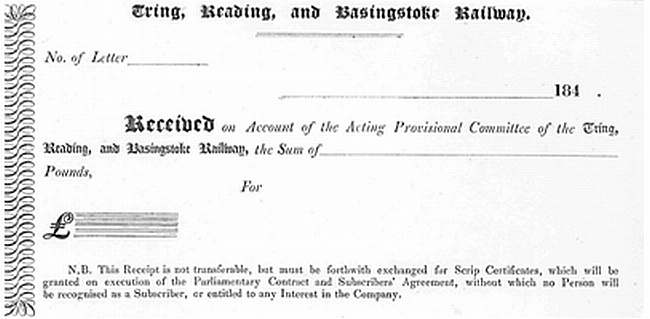
Receipt issued in 1845 by the projected
Tring, Reading and Basingstoke Railway Company.
The company was dissolved in bankruptcy in
September 1846.
By an entry in the Tring Vestry book, 4 April 1845, it appears that
application was made for power to rate in the usual manner a line
which was to have passed through Betlow, this Lordship being under a
special Act as to rating. The Railway was called the London,
Worcester, & South Staffordshire and was to have run from the
L&B at Marsworth to Worcester.
In 1846 the London & Northwestern Railway was incorporated,
including the London and Birmingham, Grand Junction, and Manchester
& Birmingham lines.
Later development. – When the L&B Railway had been opened 17
years, it was found that within a circle of two miles round each
station between the Metropolis and Tring the total amount that had
been expended in new buildings was only £22,000. It was then
suggested that if a first class pass, available for a few years,
were presented to every person who constructed a residence of a
certain annual value near the line, all parties would be benefitted.
In eight years, between £240,000 and £250,000 were spent in
house-building in those localities, and the amount expended since
has been enormous.
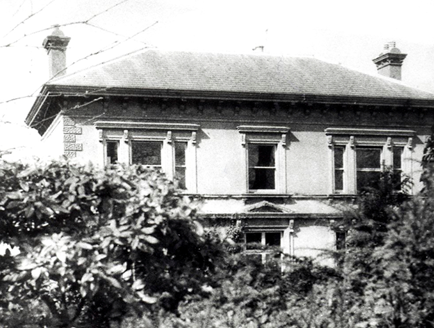
Beech Grove, shortly before demolition in
1997.
Tring did not however share in this wholesale suburbanizing, and
there is only one house whose owner took the advantage offered by
the Company of a first-class pass for 21 years.
[This was
William Brown, the father of the author of these notes. The house
was named Beech Grove, before demolition for many years the
Headquarters of the British Trust for Ornithology.]
――――♦―――― |
|
TRING CUTTING
“Leaving the Tring Station towards Birmingham the traveller passes
under a bridge, and immediately enters one of the most stupendous
cuttings to be found in the country. The contemplation of this vast
undertaking fills the mind with wonder and admiration.”
The London and Birmingham
Railway, Roscoe and Lecount (1839).

Above: an unrebuilt Royal Scot-class locomotive and train in Tring Cutting.
Below: Midland Compound 1114 in Tring Cutting.
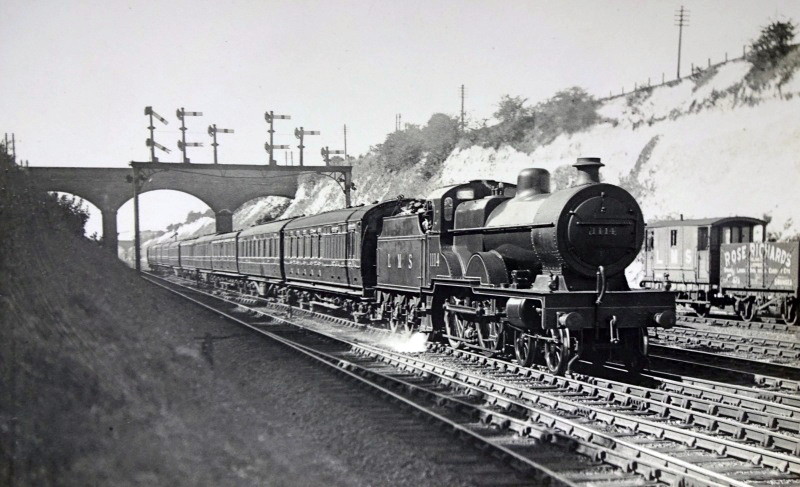
A Midland Compound in Tring Cutting
Stephenson was well aware that one of the most labour-intensive
tasks along the route would be the excavation of the 2½-mile Tring
cutting. Thomas Townshend (1771-1846), an established civil
engineering contractor from Smethwick, secured the contract to
construct the 6-mile section of the line from a point to the north
of Tring Station, his tender price being £107,250. Although
approaching the end of his career, Townshend was very experienced in
heavy earthworks, drainage and canal cutting, having earlier worked
on projects for the great civil engineer John Rennie Snr.
Townshend’s responsibilities were considerable. Not only did they
entail the construction of the cutting, numerous bridges and the
very long embankment to the north of the cutting, but he also had to
build culverts and drains, erect fencing, and lay the rails, blocks,
chairs and sleepers. All this he was required to maintain in good
order for a year after completion.
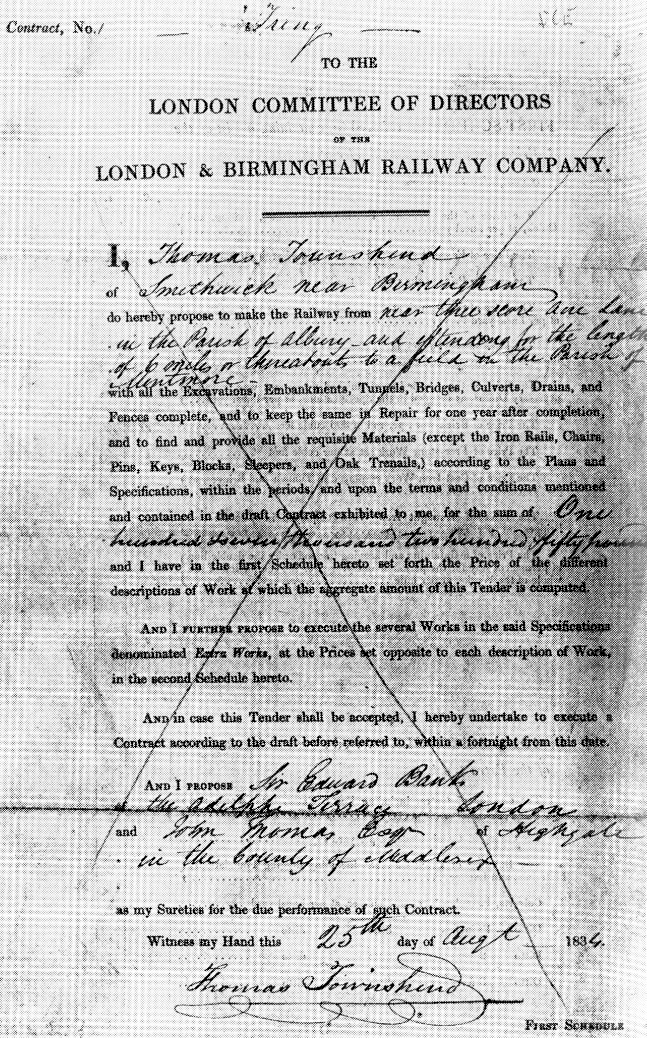
|
The first page of the contract for
excavating Tring Cutting and for other work,
including the long embankment to the north. It was
signed by Thomas Townshend on 25th August 1834. The
contract price of £107,250 included keeping all the
works in good repair for one year after completion. |
Because of the size of the task, work commenced on the cutting in
1835, well ahead of other work in the Tring area. Townshend set up
his headquarters and pay office at Ivinghoe, probably at the
Kings Head, from where he supervised his army of sub-contractors
and labourers. At first, all went moderately well. Apart from the
huge volume of chalk to excavate, it was anticipated that there
would be problems with the workings being flooded by groundwater (if
not by the weather!):
“The excavation,
through Tring-hill, is proceeding rapidly. Mr Townshend, the
contractor, has upwards of 500 men employed besides a great number
of horses. It is expected they will intercept the Bulbourne springs
when they get deeper. These springs at present come directly into
the Grand Junction Canal . . . .“
The Mechanics’ Magazine
(vol.23) 1835.
. . . . and as the lower levels of the chalk terrain – which form an
aquifer – were reached, so commenced the predicted flooding. It was
also anticipated that weather conditions would turn the bottom of
the cutting into a mire, and that this would also hamper progress:
“In the event of a
sharp frost, the ground, which is a sort of chalk rag, will slake
down like lime, and will consequently be a great nuisance after the
rail is finished. The banks of the GJC,
[Grand
Junction Canal]
in the deepest cuttings
collateral with the railroad, are more than one to one, yet the
slips which have occurred after a frost have been prodigious.”
The Mechanics’ Magazine
(vol.23) 1835.
Following the line’s opening to Tring in October 1837, the
groundwater encountered in the cutting and the weather combined to
make working conditions impossible. In his history of the line,
Peter Lecount, one of Stephenson’s engineers, writes:
“The Watford Tunnel was
finished, and but little remained in the excavation. The state
of the three succeeding contracts was also very satisfactory.
The North Church (sic.) Tunnel was
finished; and, with the same exertions on the part of the
contractors which had hitherto been evinced, there appeared no
reasonable doubt but that the works might be all completed, and the
line opened to Tring in the autumn. The quantity of water
yielded however by the Tring cutting, in addition to that which had
fallen in rain, together with the argillaceous character in the
chalk in that cutting, rendered absolutely necessary to stop all
proceedings on that embankment. It had, in fact, been
proceeded with, till it was at last quite impossible.”
A History of the Railway
connecting London and Birmingham, Peter Lecount (1839).
Stephenson submitted regular reports to the Railway Board relating
on the progress of the work and its cost. In February 1838, he
reported that:
“The Tring contract,
which comprehended the most extensive excavation on the line, is now
nearly completed . . . . it has, however, been impracticable to
proceed as intended due to the intense and protracted frost, which
set in a few days after the beginning of the year, continuing up to
the present date, without a single available interval of one day. The contractors have been urged, and every expedient resorted to,
for the purpose of proceeding with the permanent rail, so as to
expedite the approaching opening, but without success. There still
remains work which, as nearly as can be calculated, must require
three weeks to perform, after a thorough thaw has taken place.”
Lecount summarised as follows:
“The railway opened to Tring in October 1837, as had been
anticipated; but a winter of unusual severity and duration, by
retarding the remaining works, made the farther opening in January
1838 impracticable; so intense, in fact, was the cold, that the
ground was frozen two feet in depth, and although, by means of large
fires and using hot mortar, brickwork was in some cases carried on,
every one at all conversant with such works, will readily know how
much time must be necessarily lost under weather which for weeks
kept the thermometer at nearly zero.”
A History of the Railway
connecting London and Birmingham, Peter Lecount (1839).
The minute book of the Institution of Civil Engineers (vol. 90, part
4) records Stephenson’s comments on the immense volume of ground
water that flooded into the workings:
“. . . . The Tring
cutting on the L&B Railway presents another forcible example of the
constant and rapid absorption of water by the chalk. In the
execution of that cutting a very large quantity of water was
encountered, notwithstanding the situation was on the summit of the
chalk ridge, forming the actual brim of the basin, where it could
not be supplied with any water but such as fell upon the immediate
neighbourhood, yet it yielded upwards of one millions gallons per
day [50 cubic feet], and continues to yield an extraordinary quantity up to this
hour, without any sensible diminution.”
A further difficulty arose when the Grand Junction Canal Company
claimed that the excavation had resulted in a considerable loss of
water that would otherwise have flowed into the canal’s summit,
which lies a short distance to the west of the railway cutting. Although Stephenson had the flow measured and disputed the argument,
the canal company threatened legal action. To settle the issue, the
railway company undertook to build a tunnel through which drainage
water could flow from the railway cutting into the canal’s summit,
an exercise that added to the cutting’s expense.
Arthur MacDonald’s account (c.1890) helps to confirm and
explain this:
“Much water was met
with in making the Tring railway cutting, and culverts were laid
below the level of the rails on each side, which carry considerable
quantities of water to the Canal by a tunnel under Parkhill Farm.
One result of the cutting was to drain Bulbourne Pond entirely. It
was a long sheet of water, three-quarters of an acre in extent, and
in the report made in 1838 on the damage, which was assessed at
£150, it is described as a very delightful place from which any
good-sized fish had been taken . . . .”
This pond – also known as “Bulbourne Water”,
for it was quite a large expanse – was on the Grove Estate, at that
time in the ownership of the Seare family.
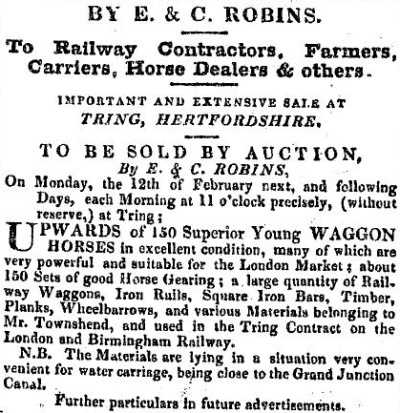
|
Sale of Thomas
Townshend’s assets. Both advertisements
appeared early in 1838. It is
interesting to see the wide range of
equipment that a railway contractor of
the age had to provide, indicative of
the private capital that was necessary
to undertake such work. |
|
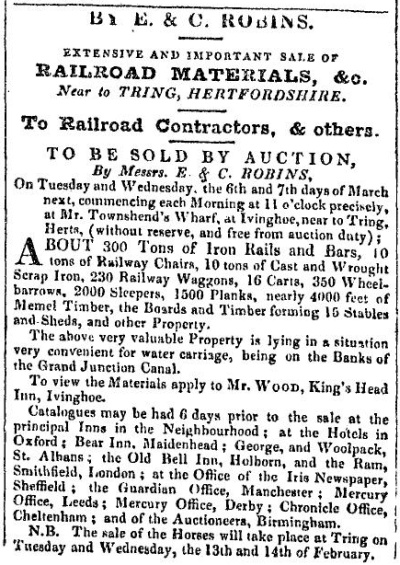 |
Auction of Townshend’s assets. The Derby
Mercury, 24th January 1838.
|
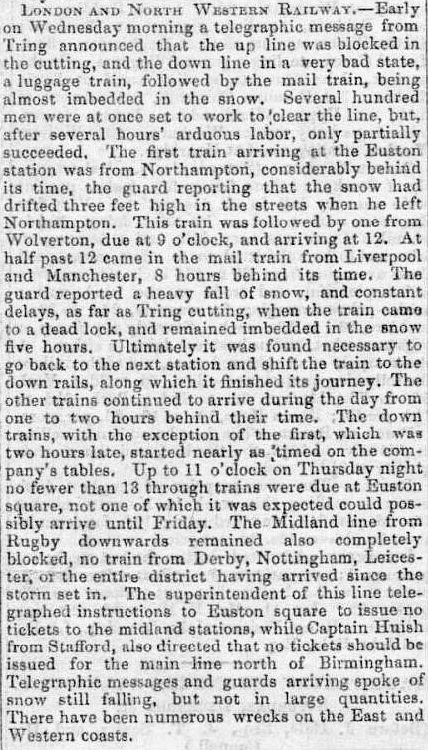 |
|
Bucks Herald,
7th January 1854. |
Apart from problems with the weather and the terrain, another blow
was dealt when Townshend was forced to relinquish his contract. He
had been hit by rising labour rates and the problem of finding
sufficient local accommodation for his large workforce, and his
costs began to outstrip his estimate for the work, a familiar story
throughout the whole of the construction work. The railway company
had assisted other contractors with loans for temporary housing, but
refused to help Townshend. In October 1837, he filed for bankruptcy
in the sum of £24,212. Townshend was just one of eleven of the
original 30 contractors employed on the line to fail, although his
failure came as a surprise, as Peter Lecount relates:
|
“. . . . the person
who had the Tring contract became bankrupt – a matter least
expected, perhaps, of any. He was a man of capital talent, and had
an established reputation for years as an able contractor. The works
he had on hand were of the most extensive nature, and ought to have
paid him well; when, to the surprise of everyone who knew him, he
was suddenly declared to be in difficulties . . . . leaving the work
at Tring, including the heavy cutting through the chalk, to be
finished as best it might.”
A History of the Railway
connecting London and Birmingham, Peter Lecount (1839).
|
The cutting was eventually completed under the supervision of the
Company’s engineers using some of Townshend’s staff to control the
workforce, its final cost being £144,657 against the contract price
of £107,250.
To take on a civil engineering project, such as that at Tring, a
contractor needed to engage an appropriately skilled workforce and
provide them with a wide range of equipment. This is evident from
the advertisements for the auction of Townshend’s assets, which give
some idea of the amount of capital that a contractor required to set
up in business. Further advertisements six months later imply that
Townshend’s property was used until work on his contract was
complete. In June, 1838, a further sale was held at Pitstone, in
which chain pumps, block cranes, a large Iron Crab windlass, timber
and stone carriages, as well as materials from many temporary
erections used to supply the needs of the dozens of horses (e.g
the contents of several large stables), blacksmiths’ bellows,
anvils, vices, and a chaff-cutting machine, were put up for sale.
|
 |
|
A farmer’s bridge near Pendley
Cottages. |
A deep cutting necessarily entails the construction of road bridges,
which require a small army of bricklayers, joiners and labourers. Four bridges cross the Tring railway cutting – at Tring station, a
farmer’s accommodation bridge near Pendley Cottages, Marshcroft Lane
and Bulbourne (Folly Bridge, where the cutting reaches its
maximum depth).
Little can be seen of Stephenson’s original bridges, for they were
largely reconstructed when the cutting was widened in 1859 (to three
lines) and 1876 (to four lines), and during the electrification of
the line in the 1960s, but all remain three-span arches with a new
48 feet centre span. Jean Davis writes in Aldbury, the Open
Village (pub. 1987) that a map of 1840 shows another bridge,
which carried the church path across the railway. This bridge was
later removed by the railway company to make way for further
development, and the resulting compensation (£140) was used by
Aldbury Vestry to build a house for the village school master.
――――♦―――― |
|
THE NAVVIES
|
 |
|
The navigator, known as a
‘navvy’
or ‘banker’. |
In his notes, Arthur MacDonald describes the navvy’s working
practices and the arduous nature of their existence, which required
skill to avoid serious injury. Today, people generally think of the
navvy as Irish; some were, but the majority were English or Scots
with a smattering of other nationalities. In this area, many were
local men who, due to the agricultural depressions of the early 19th
century, lived in the shadow of the workhouse. In the public mind,
navvies were generally reckoned rough and depraved, and in the towns
and villages along the railway’s route they were awaited with
apprehension – if not trepidation – and sometimes with
good reason, as the following accounts from the Tring Vestry Minutes
illustrate:
|
14th March 1836. Boxmoor.
A great riot took place here last night between the English and
Irish Bankers working on the new railroad.
30th September 1836. Berkhamsted. There was a great riot here
today. A party of Irish navvies passing through the town were
attacked by parties of navvies working on the L&B railroad. The
Irish navvies were knocked down, severely beaten, stones thrown at
them, and dogs were set on them to tear them. The Irishmen returned
again later in the day, and there was a great riot in the town. Several inhabitants of the town assembled and took some of the
rioters into custody. There has been a lot of disturbances in the
neighbourhood with these men, many of whom are but rough uncouth
savages, as fierce as tigers.
See also
Annex. |
In spite of such disturbances, while endorsing the general view, the
civil engineer Peter Lecount suggests that acts of violence –
presumably on the local populace, rather than among themselves –
were rare:
“These banditti, known in some
parts of England by the name ‘Navvies’ or ‘Navigators’, and in
others by that name of ‘Bankers’, are generally the terror of the
surrounding country; they are as completely a class by themselves as
Gipsies. Possessed of all the daring recklessness of the Smuggler,
without any of his redeeming qualities, their ferocious behaviour
can only be equalled by the brutality of their language. It may be
truly said, their hand is against every man, and before they have
been long located, every man’s hand is against them; and woe befall
any woman, with the slightest share of modesty, whose ears they can
assail.
From being long known to each other, they in general act in concert,
and put at defiance any local constabulary force; consequently
crimes of the most atrocious character are common, and robbery,
without any attempt at concealment, has been an every-day
occurrence, whenever they have been congregated in large numbers;
but they were so thinly scattered over the London and Birmingham
Railway, that their depredations partook more generally of a
deceptive character, and acts of violence were rare.”
A History of the Railway
connecting London and Birmingham, Peter Lecount (1839).
A long account of life as a navvy was written by a well-educated
young man whose ambition was to become a civil engineer ― whether he
succeeded is not known, for his account is anonymous. He left a
first-hand record of his work on the construction of the line
between Watford and Tring, including everyday problems, some of
which could arise from a most expected quarter:
“In February 1836 Frazer
[an engineering contractor] took a
contract to dig ballast at Tring; and I was sent down to have charge
of the job; on which there were about 50 men employed. The job was
bravely started, and things went on smoothly enough for the first
ten days, when, lo! It was reported that there was a bogie
[gremlin] in the ballast pit.
These men who could defy alike death and danger became panic
stricken. The idea that the pit was haunted filled them with a
mortal terror, of which the infection heightened as it spread.
At first the current rumour was that picks, shovels, and barrows
were moved from their places nightly by the bogie; then it came to
be that earth was dug, barrow-runs broken up, tools spoiled, trucks
shunted, and even tipped by his nightly visits . . . . Finally the
men struck work in a body. Reasoning with them was useless;
the old ganger, as spokesman for the rest, declared as the result of
his former experience that ‘there was no tackling the old un’
[the Devil], and to a man
they refused to re-enter the pit.
. . . . Frazer came down the same night, bringing with him a band of
chosen roughs from Watford tunnel . . . . Frazer expected much from
this gang; and the next morning they commenced work in earnest. But
on the second day they too became possessed with the same
superstitious terror as their predecessors; and they also struck. Persuasives, promises, and threats were alike unavailing; the men
would not ‘go agin the bogie’; and the pit was once again deserted.
Frazer raved like a madman. He was under a penalty to dig so much
ballast per week . . . . suggested to set on a gang of farm
labourers; of whom there were plenty out of employ. He assented;
and, in a day or two, we were at work again swimmingly; and
continued so for a week, when the old contagion showed itself, and
another suspension appeared inevitable. It came at last, but was for
some time averted by the allowance of rations of tommy in addition
to wages, and by seeing that every man was half drunk before he went
to work . . . .”
‘Navvies as they used to be’, from
Household Words, Vol. XIII. (1856).
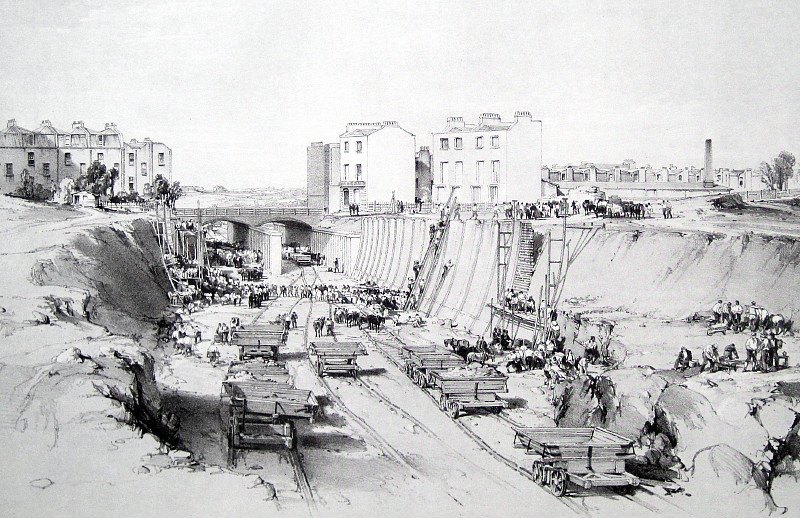
Navvies excavating a cutting near Camden on the
London & Birmingham Railway, September 1836,
by John Cooke Bourne.
Many among the local populace became so concerned by various aspects
of navvy behaviour that it was felt that something had to be done to
point out to them the error of their ways:
“. . . . in the summer of 1836,
the fearful depravity of the men working upon the railways, and the
demoralizing influence upon the surrounding population, became a
matter of public notoriety; and missions were organized by various
religious sections of the community . . . .
The object was most praiseworthy; for by no class was reformation
more radically required than by railway makers of every grade, from
gaffers to the tip-boy . . . . Thus, many well-dressed, and
doubtless well-meaning persons, obtained permission to visit the men
on the works, during meal times, with the view of imparting
religious instruction to them, and did so. The distribution of
religious tracts, and the usual machinery of proselytism, were
shortly in active operation and the men’s dinner-hour, instead of
being a period of rest and relaxation, was converted into a time for
admonition and harangue.”
‘Navvies as they used to be’, from
Household Words, Vol. XIII. (1856).
Some of this evangelizing did not fall on deaf or resentful ears, as
Berkhamsted local historian Henry Nash writes in 1890:
“Some of the men were as brutal
as tigers, while there were others who were noble, manly fellows,
and who but for their drinking propensities, would have made their
mark in the world in any pursuit of life. There were also a few
among the foremen who, in addition to their superior intelligence,
were remarkable for their sobriety and for their religious
principles. It is to these men that Berkhamsted is indebted for the
introduction of Wesleyanism into the town . . . .”
It is reasonable to suppose that the same applied to a few at Tring,
but it is likely that the majority were unmoved and persisted in
their favourite pastimes of drinking, pugilistic encounters, and dog
fighting.
Apart from the dangers inherent in a navvy’s leisure hours, most of
which stemmed from drink and the squalor in which they often lived
(contagious disease, such as smallpox, cholera, and dysentery often
struck), life in the workings was inherently dangerous in an age
when ‘health and safety’ had yet to be thought of. John Cooke
Bourne’s famous picture showing the excavation of Tring cutting
(below) illustrates just one significant risk, the ‘horse-run’. On the face
of it, using a horse to haul a man up the side of a cutting, while
he guided a barrow loaded with several hundredweights of spoil,
might seem straight forward, but when the rope gave away or the
horse panicked and bolted, the consequences could prove fatal.
However, before the spoil could be lifted up the horse-run, it was
first necessary to cut it out of the sides of the cutting. This too
could prove a dangerous operation:
“In
excavating a deep cutting, they [the navvies]
would work it as much as possible in ‘lifts’ or ‘benches,’ by which
the ground was so undermined at the bottom as to produce a large
fall of earth. The last operation was called ‘knocking the
legs from under it;’ and if the earth did not readily fall,
sharpened iron piles and bars were driven in from above to force
down the ground. From ten to fifty tons would thus be brought
away at a time; but not infrequently with one or more men buried
under the mass.”
The Quarterly Review, Volume 103
(1858).
|
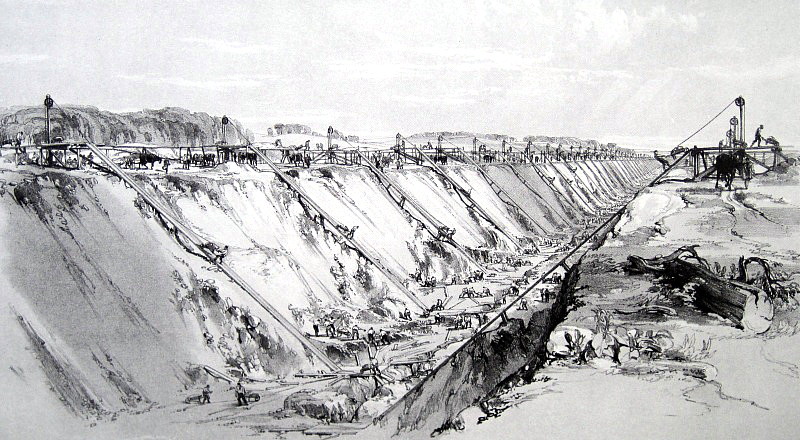
|
“Upwards
of a thousand men are engaged in making
the Tring railroad cutting. Horses
attached to a windlass draw the barrows
laden with soil up inclined planks, the
labourer merely guiding the barrow.
It is very dangerous work, and
unfortunately there have been several
accidents. In Hertford Museum is
an engraving depicting the work.
It is dated June 17th 1837.”
From the
Tring Vestry Minutes for 1837. |
|
|
 |
|
Horse runs, drawn by John Cooke Bourne, June 1837.
Top, at Tring Cutting. Bottom, at the Boxmoor
Embankment. |
Tunnelling was the civil engineer’s nightmare, for it was impossible
to foresee with confidence what lay beneath the surface. Subterranean streams and, worse still, pockets of quicksand and
gravel might be concealed, which, when pierced, would pour into the
workings in a torrent until the cavity it occupied was empty. Then,
no longer able to support the weight of the ground above, the cavity
would collapse, burying the workings and those unfortunate not to
have got out in time. This incident occurred during construction of the
Northchurch Tunnel to the south of Tring station:
“The soil through which we were
carrying the drift of Northchurch tunnel was of a most treacherous
character, and caused many disasters. Despite every precaution, the
earth would at times fall in, and that, too, when and where we least
expected. Thus, in the fifth week of our contract, notwithstanding
that our shoring was of extra strength and well strutted, an immense
mass of earth suddenly came down upon us. This came from the tapping
of a quicksand. One stroke of a pick did it. The vein was shelving
and the sand, finding a vent, ran like so much water into the open
drift; which was of course speedily choked up. George Hatley was at
once on the spot; and, under his directions efforts were promptly
made to clear away the sand, so that the shoring should be
re-strengthened if possible before the earth above (deprived of the
support afforded by the sand) should collapse. The most strenuous
efforts were made in vain. There came a low rumbling, like the
distant booming of artillery, then followed crashes louder than the
thunder, startling us from our labour; and, while we were hurrying
away, down came the whole mass of earth, masonry, timber, and sand,
crushing five men under it. Of these men three were dug out alive,
and removed terribly mangled – to the West Herts Infirmary; the
other two were found dead.”
‘Navvies as they used to be’, from
Household Words, Vol. XIII. (1856).
|
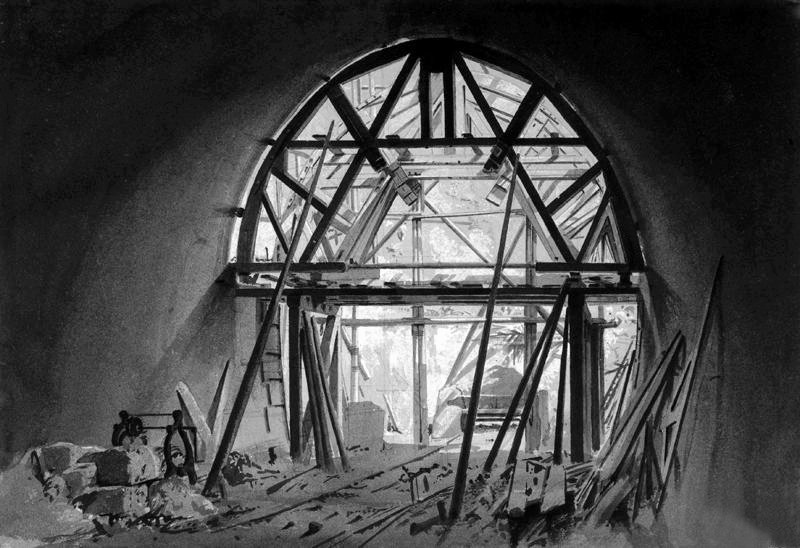 |
|
Northchurch Tunnel under construction.
Above:
by John Cooke Bourne, July 1837. Below: by S. C. Brees, September 1837. |
|
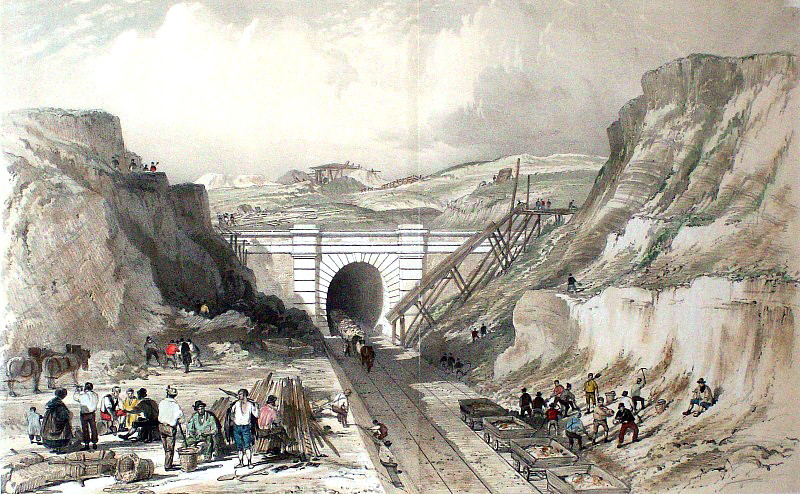 |
A similar incident occurred during construction of the Watford
tunnel, where the terrain is predominantly chalk, but soft chalk
interposed with gravel-filled fissures, as much as one hundred feet
deep:
“The gravel is most abundant in
the neighbourhood of Watford, covering the upper chalk which in many
places it penetrates, or in other words, the large fissures or rents
in the chalk are filled with gravel, and as this latter material is
very loose and mobile, it was the occasion of much difficulty and
danger in the excavation of the Watford tunnel; for at times, when
the miners thought they were excavating through solid chalk, they
would in a moment break into loose gravel, which would run into the
tunnel with the rapidity of water, unless the most prompt
precautions were taken.”
The London and Birmingham Railway,
Thomas Roscoe and Peter Lecount (1839).
Such gravel-filled fissures were cut into on several occasions, but
on the 17th July 1835, there occurred a huge inrush of gravel. Ten
of those at work in the tunnel were buried alive. So much for the
dangers of the navvies’ work.
During construction of the railway at Tring, some of the workforce
are known to have lodged in the town. What little is known about
Tring’s medieval Priory, which stood on the site of today’s Library,
come from an account by an unnamed author published in 1838 in
Railroadiana, a new history of England. After the Dissolution of
the Monasteries, the Priory building served various purposes
including, from 1718, use as Tring’s House of Correction, later
renamed the Workhouse. It was then converted into a residence for
farmer William Beal, part of which he used as a lodging house for
‘travellers of the working class’.
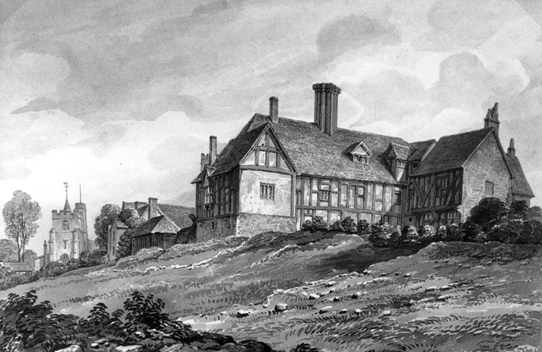
The old Priory building.
An 1837 extract from Tring Vestry Minutes records that:
“The old Workhouse has been
converted into a lodging house for travellers. William Beal, the
tenant, is fortunate in having just now a large number of the
excavators, or bankers as they are called, engaged in making the new
Railroad, lodging with him.”
A year later Railroadiana tells us that over 100 workers were
boarded there, all labouring on the construction of the line and the
massive cutting through the hills east of Tring. According to this
account, the lodging house was a jolly place, especially on Friday
nights when the beer flowed freely in what had once been the monks’
kitchen. A visitor of the time (clearly not an admirer of Henry
VIII, but even less an admirer of monasteries) wrote a ten-verse
poem on the subject, four of which appear below:
|
TRING PRIORY
Strange changes mark the flight of time:
Three centuries since men wondering saw,
The old abodes of cant and crime,
Abolished by a despot’s Law.
Heaven with base instruments works good,
A pregnant instance we have there;
The wretch who shed a consort’s blood,
Made tyrant priests and monks despair.
And thus perhaps it was that Tring,
Though at the time it zealots shocked,
Was cleansed by a ferocious king
From knaves who truth and virtue mocked.
We ask not who successive pass’d
Next occupants of this secure,
The fabric we behold, at last,
Came “Heaven directed to the Poor”.
Now industry on every part,
Its hand has laid in manly strife,
To render each with rustic art
Appropriate to humble life.
Where monks sung, those who guide the plough,
And those who dig until nightfall.
And in the Chapel-stable now,
A horse enjoys the only stall.
The world goes round, I see it here,
For yonder venerable pile –
Where lazy monks breathed vows austere,
Is now the scene of cheerful toil.
No more the sternly thundered doom,
Turns offending brothers pale,
But song and chorus in its room,
And mirth inspired by home-brewed ale. |
When the navvies finally completed their work, Tring perhaps
breathed a sigh of relief, although some (as recorded in Arthur
MacDonald’s notes) probably missed the additional business they
brought to the town. No doubt after their departure their old
lodging house, Tring’s Workhouse premises, needed a good tidy-up:
“William Brown – Desirable opportunity
for carpenters and builders. Directed to sell by auction on
Wednesday 30 March 1842 at one o’clock.
A large quantity of sound and very useful materials comprised in
the Old Rectory (since used as a Workhouse) at the entrance to
the town of Tring, which have recently been taken down, sorted,
and divided into convenient lots for the accommodation of
purchasers. [These included beams, joists, posts, rafters,
braces, floorboards, window frames and 1,000 cu.ft. of solid
oak.]
Catalogues will shortly be obtained from Watson’s Printing
Office, Berkhamsted.”
The Aylesbury News &
Advertiser, 26th March
1842.
――――♦――――
THE RAILWAY REACHES TRING |
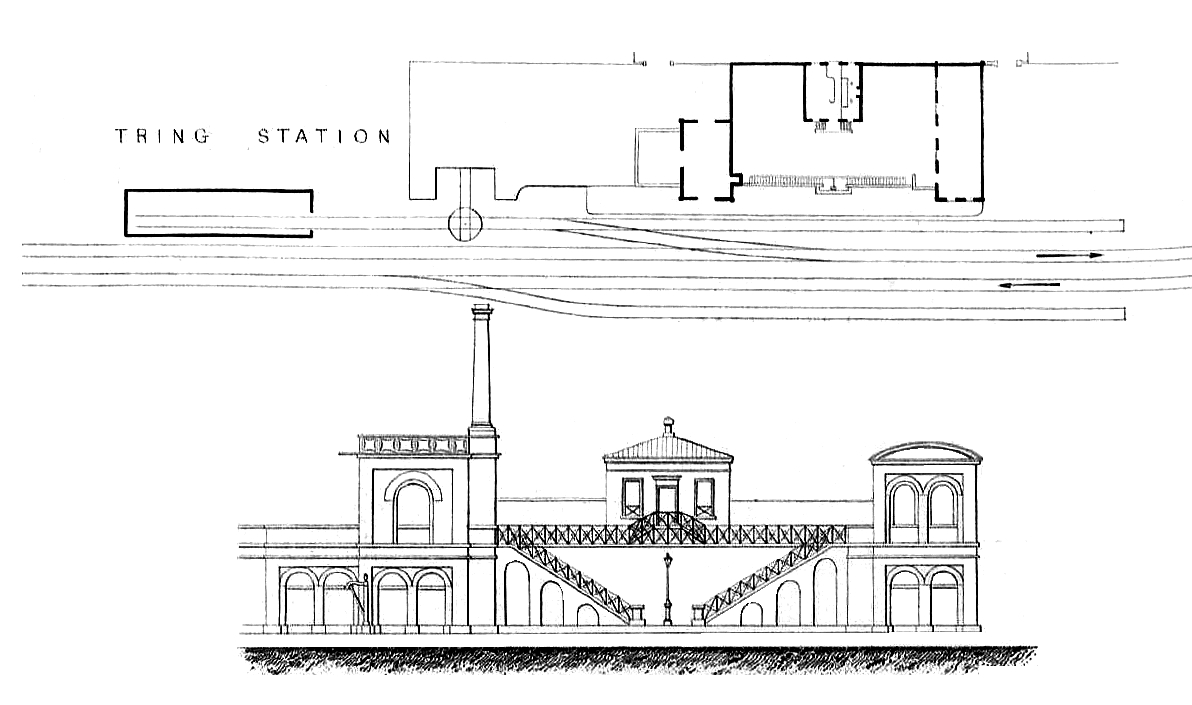
Outline drawing of Tring
Station as originally built.
The chimney was part of the gasworks that provided coal gas for
station lighting.
Our thanks go to Tom Nicholls for bringing this
drawing to our attention. It appears in
First [fourth] series of railway practice: a collection of
working plans and practical details of construction in the
public works of the most celebrated engineers by S. C. Brees
(1847).

|
London & Birmingham Railway Bury 2-2-0
passenger locomotive No. 32 heading a mixed train.
The first carriage is a Grand Junction Railway
travelling post office, an example of which is on display at the
National Railway Museum, York. It is followed by a second-class
and then by several first-class carriages. The cylinder-like
objects projecting from the carriage roofs hold oil lamps
(it appears that second-class
passengers didn’t qualify!).
|
|
THE OPENING
The day of the opening of the line to Tring was blessed with fine
weather, and all those of importance travelled along the line. The
whole expedition, which appeared to pass without any problems, was
followed by much self-congratulation. This from the Tring Vestry Minutes:
16th October 1837 – Today the new
London & Birmingham railroad was opened as far as Tring. The
Directors and a few friends made an experimental trip in six
carriages, and the fineness of the day contributed to the pleasure
of the journey. They completed the distance to Harrow by 25 minutes
after nine, to Watford 37 minutes after nine, and to the Station at
Boxmoor by 9 minutes before ten o’clock. The train here entered on
the new line of rails.
Immediately after leaving Boxmoor Station there is an embankment of
very considerable length, at the conclusion of which there is a
short cutting of a few feet in depth, and a tunnel immediately
following the tunnel is only 300 yards in length, and the
inconvenience which has been complained of is passing through these
at the earlier part of the railroad, and the want of light therefore
was scarcely felt. An arrangement has been made with a view to
remedying this defect entirely, by the introduction of lamps into
each carriage; the regulations, it is intended, shall extend to
carriages both of the 1st and 2nd class, and the object is to be
effected by placing oil lamps in apertures in the roof of each
carriage.
The train passed through Berkhamsted Station at precisely ten
o’clock, and concluded its journey without any accident or mistake
by arriving at Tring (that is Pendley) at 10 past ten o’clock, thus
having covered the whole distance from Primrose Hill in an hour and
11 minutes.
The line of rails now laid down does not extend more than 100 yards
beyond the station, and concludes there in a deep cutting about 55
feet below the level of the earth, in soil consisting entirely of
chalk. The point at which this excavation is made is the highest
point of the whole line of the railway from London to Birmingham,
and its level is 300 feet higher than that of the station at Euston
Square, a gentle acclivity therefore, extending through the whole
distance. The journey, when the railroad is completed, will be
performed from London to Birmingham in eight and a-half-hours, but
as soon as the rails are completed the whole distance, there is
little doubt that the mails will be carried in little more than four
hours, and to Liverpool in eight and a-half, or thereabouts.
The object of the Company at present, however, is not so much to
procure speed as to secure the regular passage of their carriages,
and every train will be regularly timed on reaching its station.
Several extra engines are now in the course of building, and at the
next opening of rails, eight will be kept at all times ready to be
called into work, although three only is the number required to be
used every day.
18th August 1838 - London & Birmingham Railroad. Extract from
the Directors’ Report. The number of passengers conveyed to and from
London and Boxmoor, has exceeded all expectations. The numbers being
as follows – on 16th ult. – being 28 days from the first opening
39,855, being an average of 1,423 per day ,for which the daily
receipts average £153; during the last week, the daily number has
advanced to 1,807, the receipts being £189.
17th November 1838 – The L&B railroad is finished all through,
and a train started from Euston Grove and reached Birmingham in four
hours and a quarter.
The account in the local paper concentrated more on the aesthetic
and human aspect of the new phenomenon. The writer of a very long
report of the whole journey is breathless with admiration as he
describes the tunnels, embankments and, of course, the “steep,
precipitous trenches of chalk which shut out all prospect.”
He goes on:
“. . . . the arches of tunnels, bridges,
and viaducts, which in many cases cross the railway, the
station-houses, and the various buildings connected with the
undertaking are all built with a view to durability; they all
exhibit as much taste as could be displayed in such erections,
consistent with the strength and massiveness which are peculiarly
necessary . . . . The labourers and country folk clustered together
in many different places to view this extraordinary rapidity of
transportation and greeted the success of it with acclamations . . .
.”
Aylesbury News & Bucks Advertiser,
21st October 1837.
It is well known that where a railway opened in competition with a
canal, the canal’s trade suffered badly, to the extent that some
canals quickly went out of business. What is less well known is that
adjacent turnpike roads were similarly affected, the advent of
public railways being one of the factors that brought about the end
of the turnpike road system.
Following the opening of the London & Birmingham Railway, the
trustees of the Sparrows Herne Turnpike (Bushey to Aylesbury, via
Watford, Berkhamsted and Tring) soon found they could not afford the
cost of bridge repairs, and had to fall back on ancient legislation
to oblige the County to pick up the bill. This from the
Hertfordshire Session Rolls:
“Letter regarding the Sparrows Herne
Turnpike Trust, stating that in consequence of the great reduction
in the income of this road occasioned by the London and Birmingham
Railway, the trustees find that they are under the necessity of
throwing upon the county the repairs of all county bridges on this
road, and of 800ft. of the road at each end of such bridges pursuant
to the Act 22 Hen. VIII., c. 5, s. 9. The trustees also
request that this matter may be laid before proper authorities in
order that the county surveyor or some other person may be
instructed to attend to these repairs. There are three bridges
on the road within this county one over the canal near Hunton
bridge, another over the mill tail at the bottom of Watford, and the
third over the river near the toll house at Watford, and dividing
the parishes of Watford and Bushey.”
6th April. 1838
THE TRAINS
In 1823, George and Robert Stephenson together with two business
associates set up the locomotive manufacturing firm of ‘Robert
Stephenson & Co.’ The firm was based in Newcastle-upon-Tyne, and for
many years manufactured locomotives for both the home and overseas
markets. Its first four engines, built for the opening of the
Stockton and Darlington Railway, were something of a disaster, but
the Rocket, built four years later for the Rainhill Trials,
proved to be a landmark in steam locomotive design. In 1833,
Stephenson introduced his Patentee class locomotive. It too
was a tremendous success, and in 1836, William Cubitt, the
contractor for the Berkhamsted section of the railway, agreed to use
one as a works engine; Stephenson’s aim was clearly to demonstrate
its potential to the directors. The locomotive was shipped to London
and then up the Grand Junction Canal to Bourne End, where it was
assembled at Pix Farm and, under the name Harvey Combe,
was put to work on the line.

The Harvey Combe, pictured at Berkhamsted in
July 1837, by John Cooke Bourne.
But when it came to procuring locomotives for the working railway,
the Directors awarded the contract to the Liverpool locomotive
manufacturer, Edward Bury, who undertook to convey each passenger at a farthing per mile, and
each ton of goods at a
half-penny a mile, using locomotives built to his
specification.
Bury was a believer in small engines. Those that he supplied to the
railway were four-wheelers, so heavy trains had to be hauled by two,
three or more locomotives. Although the service contract with Bury
was soon abandoned, he continued in a salaried position as
Locomotive Superintendent until shortly after the mergers took place
in 1846 from which was formed the London and North-Western Railway.
As for passenger accommodation, at the outset there were only two
classes of carriage. First-class carriages were little more than
three stagecoach bodies mounted on a common chassis. Judging by the
Liverpool and Manchester Railway first-class coach exhibited at York Railway Museum, the accommodation was rather
cramped by modern standards, but not by those of the time:
“Upon examining the internal fittings
up of the carriages, upon which so much of the comfort of his
journey will depend, the traveller will find that the first class
carriages are divided into three entirely distinct compartments, and
these compartments into six divisions, (except in the mails, in
which there are only four) so that each traveller has an entire seat
to himself, in which he can recline as freely and comfortably as in
the most luxurious arm chair; and after the shades of evening have
gathered over the scenery; can read the news of the day; or turn
over the pages of our little volume; by the light of a lamp which is
fixed in the roof of the coach.”
Drake’s Road Book of the London
and Birmingham Railway (1838).
But if first-class was cramped, second-class was truly grim. During
the day, this class of carriage was little more than an open-sided
truck with an overhead covering, although conditions were marginally
better for travellers on the night trains:
“The second class carriages are,
however, of a very different character. These cushionless,
windowless, curtainless, comfortless vehicles, seem to have been
purposely constructed so that the sweeping wind, enraged at being
outstripped in his rapid flight, might have an opportunity of
wreaking his vengeance upon the shrinking forms of their ill-fated
occupants. At night, however, the partnership of the railway with
Messrs. Rheumatism and Co. is dissolved, and even second class
passengers are provided with shelter from the cold and chilling
blast.”
Drake’s Road Book of the London
and Birmingham Railway (1838).
Third-class carriages arrived on the London and Birmingham line some
time later, this unfortunate class of traveller inheriting what had
previously been the second-class day carriages, the occupants of
which ran the risk of being blistered by flying sparks and cinders,
and smothered with dust in the tunnels. Contemporary illustrations
show them with raised umbrellas and parasols for protection, and
with pieces of net draped over their top hats. Train journeys were
improved for everyone when it was realised that the stone blocks on
which the rails were laid did not lend themselves to a comfortable
ride, and they were soon replaced by more vibration-free wooden
sleepers.
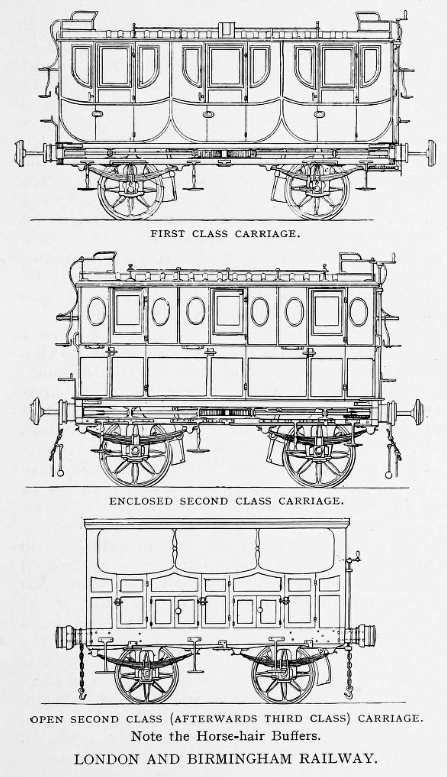
Because corridor compartments lay many years in the future, none of
the carriages gave access to toilet or buffet facilities. Regarding
luggage, this was carried on the roof:
“As was the general custom, luggage was
carried on the roofs of the carriages, and amongst the rules of the
company we read, ‘Every passenger’s luggage will, as far as
practicable, be placed on the roof of the coach in which he has
taken his place; carpet bags and small luggage may be placed
underneath the seat opposite to that which the owner occupies.’ The
practice of carrying luggage on the roof survived on some lines for
many years, but in 1845 the Grand Junction and London and Birmingham
Railways introduced baggage vans on their trains.”
History of the London &
North-Western Railway, Wilfred L. Steel (1914).
Carrying baggage on the roof gave rise to another problem, fire,
although this was only one of many difficulties to beset rail
travel in the early days:
“The railway guards also had an
unpleasant time, for, adhering to old usage they too rode outside on
the top of the carriage, where, amidst other disagreeables, their
clothes sometimes caught fire. The roadside stations were enclosed
with lofty iron railings, within which the passengers were
imprisoned until the train arrived; they were then permitted to rush
out to take their places, for which they sometimes had to join in a
free fight [not a great change there!]
. . . .
The working of the line went struggling towards a state of order. The rails were found to be too light for the traffic – 56lb.
fish-bellied rails in some cases – the stone blocks a failure; fires
to luggage on the tops of the carriages frequent; signals by flag
and hand lamps insufficient. The signalmen, dressed in police
uniform, had been drilled by Mr. Superintendent Bedford, formerly of
the Guards and lately of the Metropolitan Police, and they brought
the flag-staff round to the shoulder, as the trains passed, with
true military precision.”
Fifty years of the London & North
Western Railway, David Stevenson (1891).
|
 |
|
The Royal Carriage interior. |
The Royal Family did not become patrons of the line immediately. In
1842, the Company built a private coach for Queen Adelaide (now displayed at York Railway Museum). In the same year, Queen Victoria
took her first rail journey, travelling from Slough to London on the
Great Western Railway. From then on, she became a regular rail
traveller. On one of her earlier trips on the London and Birmingham
Railway, the Company provided a four-wheeled carriage, which was
centrally heated. Inside the saloon was a throne-like armchair upon
which the Queen sat when in public, and a more comfortable sofa
hidden behind curtains for use when travelling. The roof was domed,
its central ventilator outlet being disguised as a royal crown!
QUEEN VICTORIA STOPS AT TRING
When, in 1844, the Queen and Prince Albert first travelled north
from Euston, they reached Tring in 52 minutes, where she asked that
the speed of her train be reduced:
“. . . . the engine, which was driven by
Mr. Bury, superintendent of the locomotive department, was attached,
and immediately afterwards, at 22 minutes past nine o’clock, the
train started, amidst the cheers of spectators. It went very briskly
. . . . In the centre of it was a magnificent carriage surmounted
with a Royal crown . . . . many a labourer and farmer on the
railroad side left the labour of the field to look at the Royal
special train as it rushed rapidly along . . . . The morning was
gloomy and rainy, but, notwithstanding this, and notwithstanding the
advanced period of the year, there was something attractive in the
landscape as the train approached Tring, owing to the varied and
wooded character of the scene. The drizzling rain which was falling
at the time had not deterred a considerable number of persons from
collecting together at Tring station. This station is situated 31¾
miles from London, and was reached by the special train conveying
Her Majesty at fourteen minutes past ten o’clock; and here the train
halted for a few minutes, in order that the engine might obtain a
fresh supply of water.
|
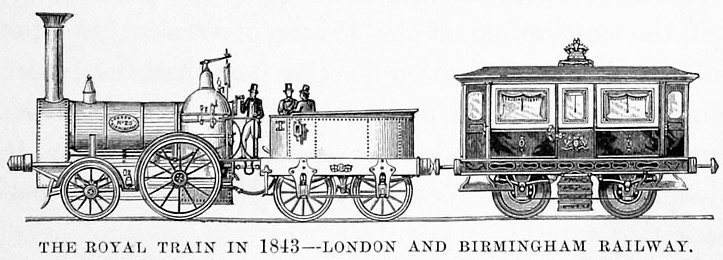 |
|
The crown on the carriage roof disguised a
ventilator cowl. |
Among the persons assembled at this station were the juvenile
members of the neighbouring population, boys and girls, who were
drawn up in rows, and who strained their tiny voices to the utmost
in welcoming their Sovereign. Her majesty appeared highly pleased
with this specimen of infantine loyalty and enthusiasm. A sufficient
supply of water having been obtained, the train again started on its
course, at 18 minutes past ten o’clock, but it was observed that its
onward rate was not now so great . . . .”
The Northampton Mercury, 16th
November 1844.
FARES AND TIMETABLES
|
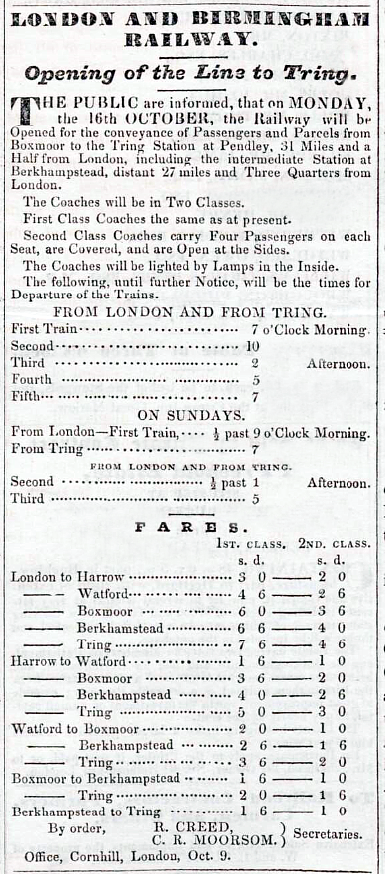 |
|
The Bucks Herald,
14th October 1837. |
At the outset, travelling by train was extremely expensive and only
really possible for the well-heeled. For example, in 1837, at a time
when a farm labourer was struggling to maintain a family on about
10s.0d a week, a second-class fare from Tring to London cost 4s.6d. Conveyance of parcels was more reasonable, for the Company was
anxious to earn revenue from goods traffic of all types. Schedules
of fares and timetables were published on the front page of local
papers, and any alteration to times was noted meticulously in
advertisements placed in later editions (important when one thinks
of the distance between Tring and its station).
These
advertisements often carried reminders of the rules that applied to
travelling on the railway, but one is left to conjecture how
rigorously they were enforced (and perhaps wish that some still
applied!). The following are a selection:
“The Public are informed that none of the Company’s porters or
servants in attendance are permitted to receive any gratuity, and
that a book is kept at every station, where passengers are requested
to note down any act of incivility or inattention of any of the
servants (stating the number on the collar), and immediate attention
will be given to the complaint by the Directors.
Females are in attendance on the ladies at the London, Watford,
Wolverton and Birmingham stations, and there is a rest at Wolverton
of ten minutes for refreshment.
Dogs will be charged for according to distance but they will on no
account be permitted to accompany passengers in the carriages.
Smoking is strictly prohibited both in and upon the Carriages, and
in the Company’s Stations. Any Passenger persisting in Smoking after
being warned not to do so, is hereby subjected to a Fine of Forty
Shillings, and in case of his persisting after a second warning, he
will immediately, or (if travelling) at the first stopping place, be
removed from the Company’s Premises, and forfeit his Fare.
Any Passenger in a state of intoxication, committing any nuisance,
or wilfully interfering with the comfort of other Passengers,
obstructing any of the Company’s Officers in the discharge of their
duty, or not attending to the directions of the Guard, in cases
where the personal safety of himself or any of the Passengers is
concerned, will be immediately removed from the Company’s Premises,
or in case he shall at the time be travelling, then at the next
Station, or as soon after the offence as conveniently may be, and
shall forfeit his Fare.”
_1841.jpg)
Table of fares in 1841, by which time
third-class had been introduced.
The list of misdemeanours for misconduct and fare dodging goes on and
on, with especial emphasis on “wilfully cutting the lining,
breaking windows, and defacing the number plates”, or otherwise
damaging carriages.
Finally, not to forget the gentry, the rates of conveyance for their
horses and carriages (a sort of forerunner of Motorail) were, in 1841 . . . .
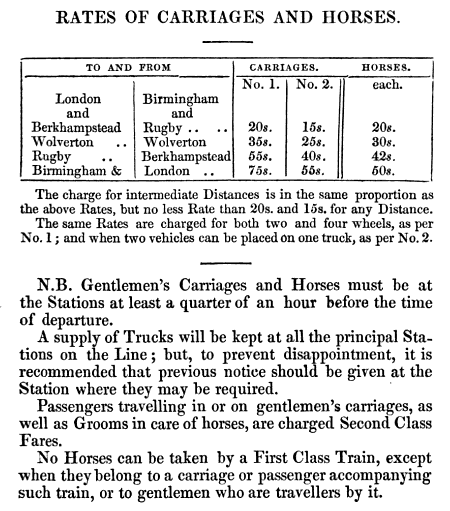 |
|
――――♦――――
TRING STATION AND ITS SURROUNDING AREA
TRING STATION
To the Editor of the Bucks Herald.
“SIR. — How is it that at the important
first class railway station at TRING there is neither a book
stall nor a refreshment room? There are many stations of
far less importance where both these establishments are
thriving. I do not individually complain at the want of
the latter, but any of the many passengers who go up by the
10.30 a.m. fast train (for instance) stopping at no station
between Tring and London have cause to grumble that they cannot
invest in a newspaper. I do not know with whom the
management of these matters rests, but as I have been told that
your arguments were instrumental in bringing telegraphic
communication to Aylesbury perhaps you will not refuse to put
forth an argument or two upon this question of lesser
consequence. If a book or newspaper stall is not soon
established, I shall certainly recommend the Directors of the
Shoeblack Brigades in London to despatch one of the most worthy
of their ‘shining characters’ to exercise the double vocation of
cleaning boots in fresh country air, and vociferating ‘Morning
News, Star, and Telegraph,’ and if the spec should
answer ‘This Day's Times, Punch, and the
Illustrated News,’ and, when anything particular is up, the
Bucks Herald, and if he should not be allowed to address
the public from the platform he can at any rate station himself
outside. . . . .
Yours, &c., M.”
Bucks Herald, 29th October 1859.
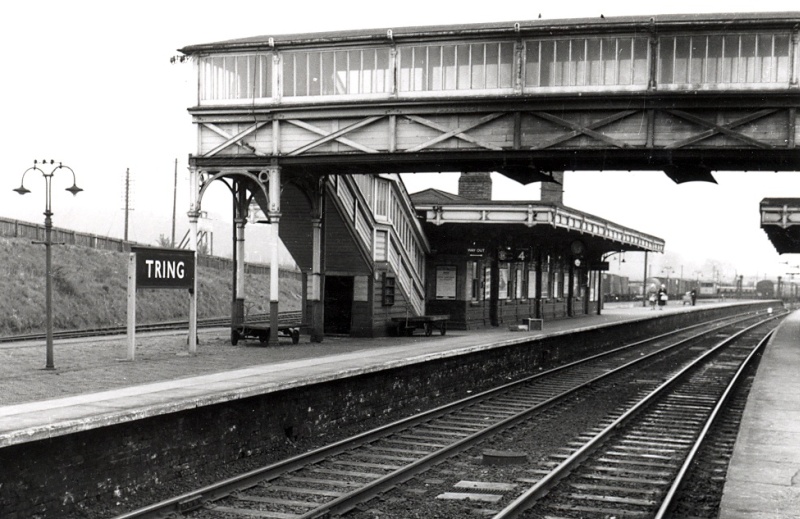
Tring Station, probably in the 1950s. Note the busy goods yard
in the distance, now a car park.
TRING’S CITIZENS
PRESENT A
‘MEMORIAL’
In his notes, Arthur MacDonald Brown first referred to Pendley
Station, its original name, some 50 years after it had opened. As he
was writing much nearer the event, it follows that his account of
how its location came about is likely to be correct, for the
oft-repeated local legend that Lord Rothschild opposed the railway
being brought through the town is clearly wrong. Nathan, 1st Baron
Rothschild, was born in 1840, just after the railway had opened and
his father, Baron Lionel de Rothschild, did not
acquire Tring Park until 1872. It was Nathan’s opposition to
a steam tramway, planned some 50 years later to link Tring Station
with Aylesbury, which would have passed his house at Tring Park,
that is probably confused with the main line.
The Comte d’Harcourt, absentee owner of the Pendley Estate, demanded
such an exorbitant price for land on which to build Tring Station
that the Company decided to build their station on a cheaper plot at
Pitstone Green, some 3 miles further north. But when the citizens of
Tring got wind of this plan, they drew up a petition and sent a
deputation to meet the directors — this from the Company’s minute
book, dated the 17th May 1837:
“Memorial signed by 169 inhabitants of the town and neighbourhood of
Tring praying that a station may be formed at Pendley and pledging
themselves to afford the Company every facility in their power for
the attainment of that object . . . . the secretary stated with
reference to the memorial that a deputation from the inhabitants of
Tring was in attendance”.
The deputation was called in, to be informed that the directors were
prepared to build a station at Tring if the townspeople undertook to
bridge the difference in price between what the Company was prepared
to pay and that demanded by the Harcourt estate. The minute book
continues:
“The deputation expressed themselves perfectly satisfied with the
arrangement, and undertook to treat for the purchase in their own
account.”
Thus, the town got its station, albeit a good mile and a half from
the town centre, for Stephenson’s determination not to exceed the
railway’s ruling gradient (1:330, or 16 feet to the mile) had
already determined its location.
Tring station has been rebuilt on a number of occasions
over the years (more recent architectural tinkerings include the
replacement of platform buildings with bus shelters). It began life
as a temporary terminus, erected to serve the extension of the
railway from Boxmoor in October 1837. Although there is no known
image or description, it might have looked similar to the temporary
terminus at Rugby, which contemporary accounts describe as “a little
wooden station of very moderate dimensions” and “in the Swiss
style, with a large projecting roof.”
Tring’s temporary terminus was soon replaced by a solid brick
building, which the Company designated a ‘first-class’ station. When
the Railway opened throughout in September 1838, its sixteen
intermediate stations fell into two categories, first and second
class, the distinction being that ‘first-class trains’ (comprising
only first-class accommodation) and mail trains stopped only at the
first-class stations, while ‘mixed trains’ stopped everywhere. All
the intermediate stations were designed by the Company’s architect,
George Aitchison Snr. (1792-1861), who considered his plans for
Tring (and also for Rugby) of sufficient merit to exhibit at the
Royal Academy Exhibition of 1838. The building contract, which
included an engine shed, was awarded to W. & L. Cubitt for the sum
of £1,885:
“London and Birmingham Railway: Amongst the many alterations and
improvements which have taken place since the formation of the above
line, there is no part which has progressed more with the times than
the vicinity of Tring. As soon as the Company had determined upon
making it a first class station (where every train stops) the
inhabitants came forward in a very spirited manner, and at their own
expense formed a new road direct to the town. Since then other
improvements have taken place, and adjoining to the station has been
erected the Harcourt Hotel, a very handsome building, capable of
affording every accommodation. The situation of this station is in a
very beautiful part of this county, in the centre of the estate of
the late General Harcourt; and in consequence of the demand for
houses in the neighbourhood, the present possessors have made
arrangements for accommodating the public with building ground at a
reasonable rate, so that in a short period we may calculate on this
spot becoming an important place. It has also become quite a
sporting district, many gentlemen who reside principally in London
finding it so extremely convenient to get to and from, that it is
treated as almost nothing to ride 40 miles to cover, and have a good
day’s sport.”
Railway Times, 7th December
1839.
While there is no known picture of this station, there is a detailed
description as it appeared circa 1840:
“TRING (FIRST-CLASS)
STATION: The station at Tring is
inconveniently placed in a cutting, as was the original Coventry
station. The offices are on elevations equal to the depth of the
cutting, and are approached from the railway by a flight of 18½
7-inch steps for foot passengers, and a sloped road for the private
carriages to be embarked or disembarked at the carriage-dock. There
is a separate passage from the railway for the departure of persons
arriving by the trains, and also a separate staircase for the use of
the porters.
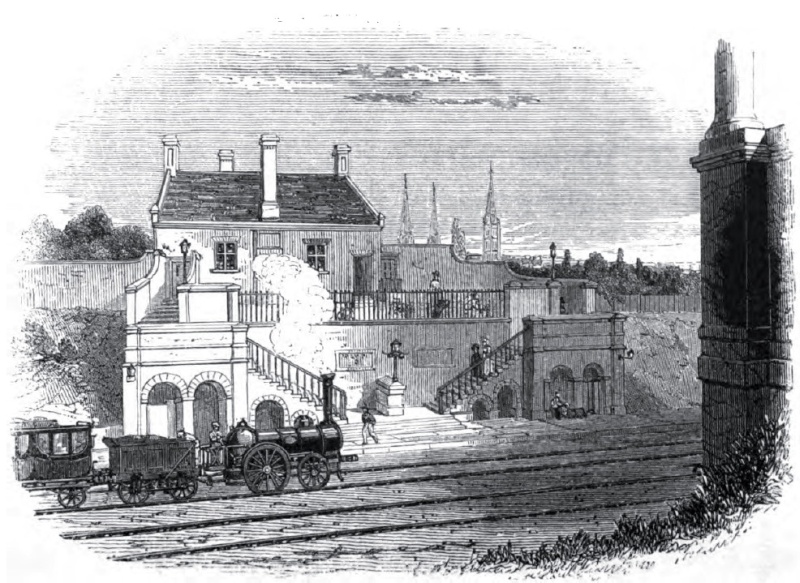
The original Coventry Station, thought to be
similar in appearance to that at Tring (c.1838).
Architect, George
Aitchison Snr. (1792-1861).
The offices consist of a booking-office and waiting-room in one,
with an entrance-lobby next the road, and exit lobby towards the
railway. The width of this building, which is constructed of brick,
is 32 ft. and the depth 24 ft.5 in. A paved yard extends in front of
the offices for a length of 58 ft. being 33 ft. in depth; the front
next the railway is enclosed with iron railings. The urinals and
water–closets are conveniently on the north side of the offices and
entered from the paved yard. There is also a porter’s lodge, which
is detached from the other offices.
The fixed-engine and boiler-house are about 33 ft. in length and 18
ft. 6 inches in width, and abut on the north side of the paved yard. The coal-shed, which is contiguous is 23 ft. in length and about 7
ft. wide. The engine has an 8-inch cylinder and 18-inch stroke; the
usual working pressure is 31 lbs. on the square inch. There are two
boilers, with return tubes. The water-tank is placed over the engine
and boiler house; the usual depth of water of 3 ft. 6 in. The
quantity of water which this tank will hold is equal to the supply
of eight or nine locomotive engines. The supply-pipes from the pumps
are each of 6 in. diameter. From the boiler the waste is admitted by
a 2½ inch pipe into the water tank, to raise the temperature of the
water previously to its being let into the tanks of tenders. Some of
the ballast engines are housed in a shed at this station.
Besides the booking clerk, there are at this station one inspector,
three policemen [in fact signalmen],
four porters, and one person to operate the stationary engine.”
The Railways of Great Britain and
Ireland, Francis Wishaw (1842).
“Marvels of
the telegraph. A man committed a robbery at Aylesbury, and
decamped by the next train. The policeman went off to
Tring Station, and telegraphed to Euston. When the thief
left the train, he was arrested by one of the police force.
The telegraph wires had caught him.”
Tring Vestry Minutes, April 24th, 1858.
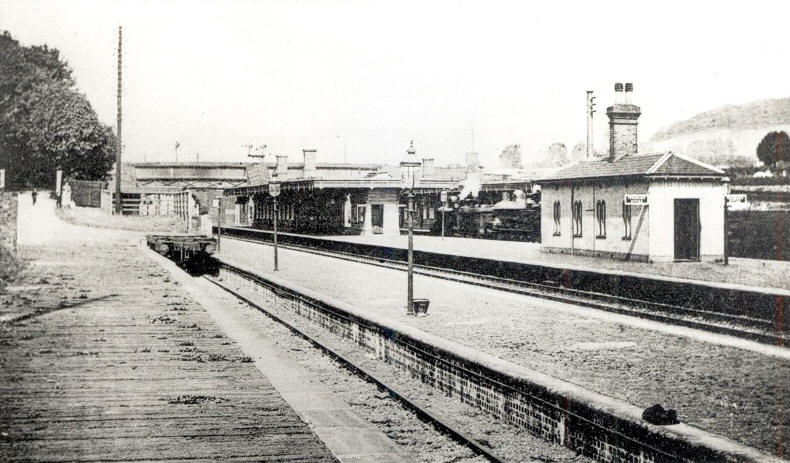
Above: Tring Station looking north
(judging by the locomotives) probably during the Edwardian era.
Below: Tring station booking office. The Station Masters house is on
the left.
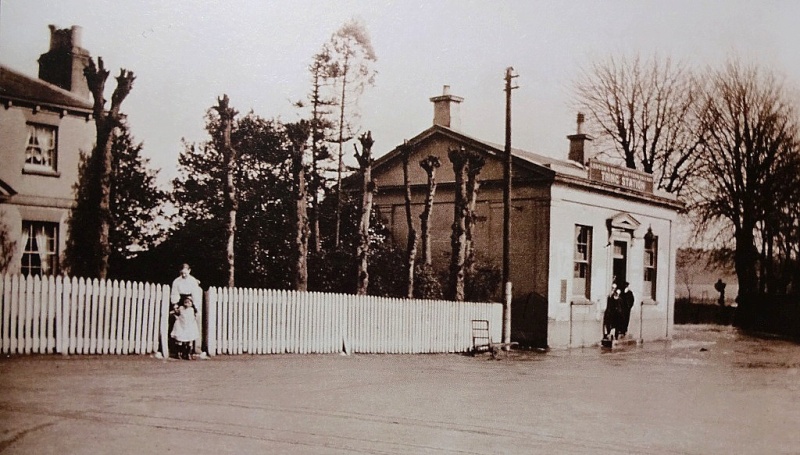
A good water supply is important for the operation of
steam locomotives, and without public water mains and at 420 ft.
above sea level, it was necessary to sink a well (80 ft. deep
according to Wishaw) and install a pumping engine (the “fixed-engine”
described above) to raise water from it. A carriage dock was added
to the west side of the station to permit the aristocracy to
transport their carriages, horses and servants, about which Wishaw
tells us that:
“The carriage dock is approached by a siding from the main line,
furnished with a 12 ft turntable opposite the entrance to the dock .
. . . One horse-box and carriage-truck are kept at this, as at all
first-class stations.”
[The term ‘railway carriage’
originates from this early usage.]
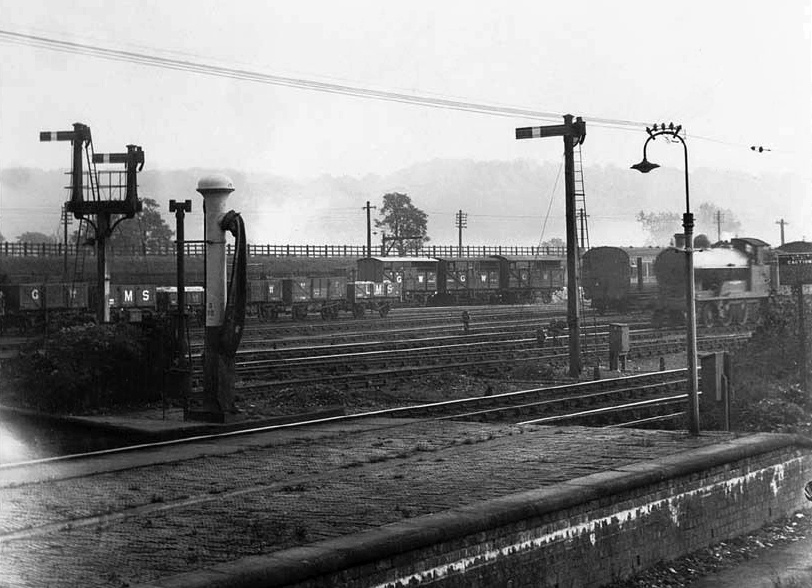
|
Above: Tring
Station yard looking
south. The locomotive is probably a Bowen Cooke Prince of Wales.
Below: down Euston Manchester express passing Tring
behind Midland Compound 1114. |

EARLY PLANS OF TRING STATION.
Although there is no known image of the first station at
Tring, there are early plans that show its layout ― very
different to that which exists today. Note the flights of
stairs descending to platform level (on the plan, adjacent to
the ‘Station Yard’) reminiscent of those at Coventry station (above);
also the waiting rooms and urinals, both facilities that are now
long gone!
The following plans are reproduced by kind permission of
Russell Burridge: |
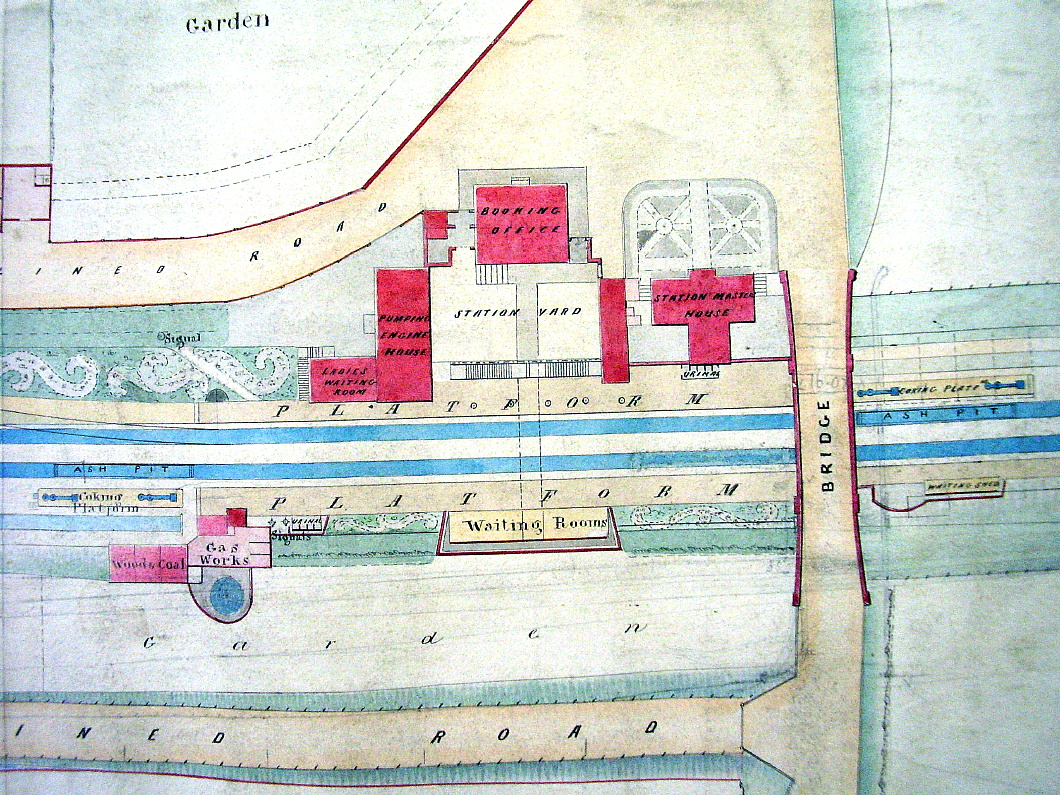
|
Above: an undated plan, but probably of the northern end of the
station in its earliest form. Note the garden fronting the
Station Master’s
house, today part of
the station forecourt.
Below: an early plan of
the southern end of the station. The circles shown on this plan
are turntables — referred to at the time as
“turn-plates”.
They were such a novelty that Osborne gave a complete
description of the operation of what he described as a
“profound contrivance” in his guidebook (1840).
Referring to those serving the goods shed and cattle dock, he
had this to say:
“The mode in which heavy goods and carriages
are placed upon the trucks, is well worthy of notice. At the
Station there are several turn-plates on the line; they consist of
large flat circular iron plates, of twelve feet in diameter, with
two lines of railing on them, the one crossing the other at right
angles, the plate turning round on iron rollers beneath, and capable
of being moved with very little power. One of the trucks which
is to receive a carriage, or heavy goods, or a box for horses, or a
pen for sheep or pigs, is pushed on to one of these turn-plates, and
being turned to a right angle, is then passed up a short line of
rail to an embankment or stand of the same height as the truck, and
the animals, goods, or carriage placed on. The truck is then
taken back to the turn-plate, and turned on to the line again.
By this apparently simple, but in reality, profound contrivance, the
heaviest and most cumbrous loads are managed with the greatest
ease.” |
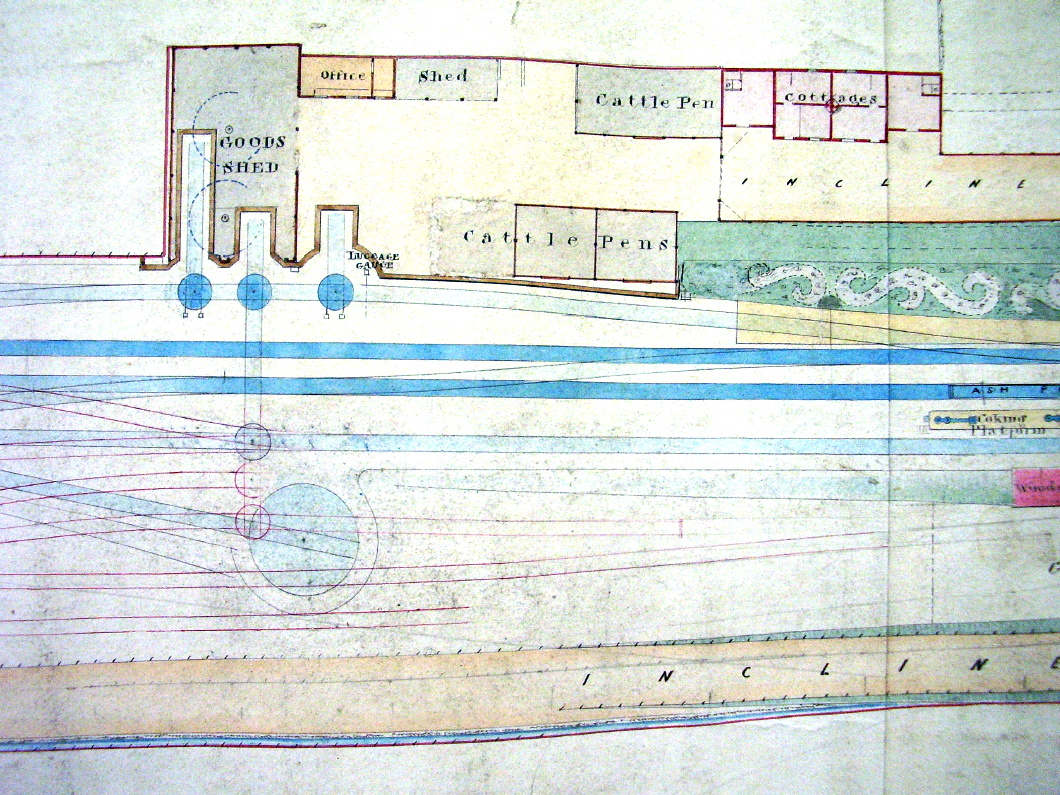
|
Below: this plan of Tring Station shows the Harcourt Arms —
later renamed the Royal Hotel (now private apartments) — and
above it the row of ‘railway cottages’ that stand in Station
Road. The railway is double track — a third track was
built in 1859, and a fourth in 1872. |
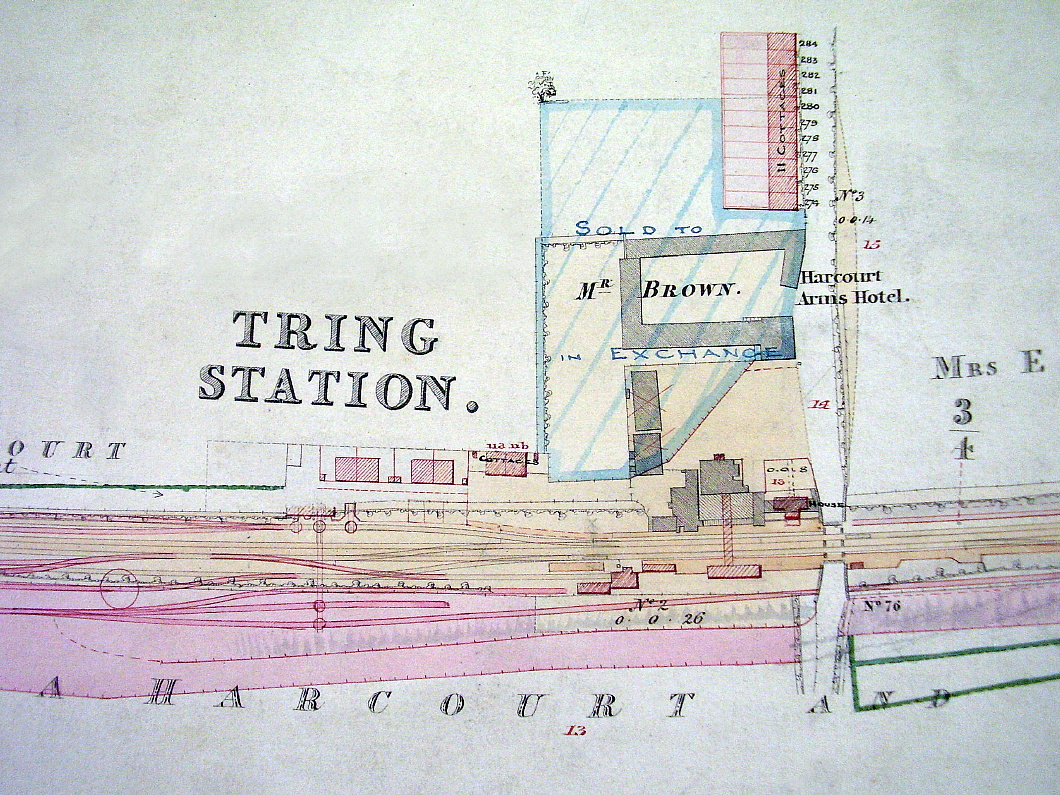
|
It seems that some of the station’s early structures did not survive
for long, for an advertisement placed by land agent William Brown in
The Bucks Herald in 1842 announces:
“TO BUILDERS AND OTHERS:
To be sold by auction, by Mr. W. Brown.
On Wednesday next at one o’clock at the Harcourt Arms
[later
renamed the Royal Hotel], Tring
Station. All the very useful materials comprised in the twelve
temporary dwellings erected by the London & Birmingham Railway
Company at the Tring Station. Also the entire roof and
materials of the engine-house at the said Station, 45 ft. by 21 ft;
two pair of very strong circular folding doors; 17 ft. 6in. by 12
ft. 6in. six strong iron-framed circular windows and frames, 9 ft.
wide; and iron piping. York stone steps, and other useful
materials.”
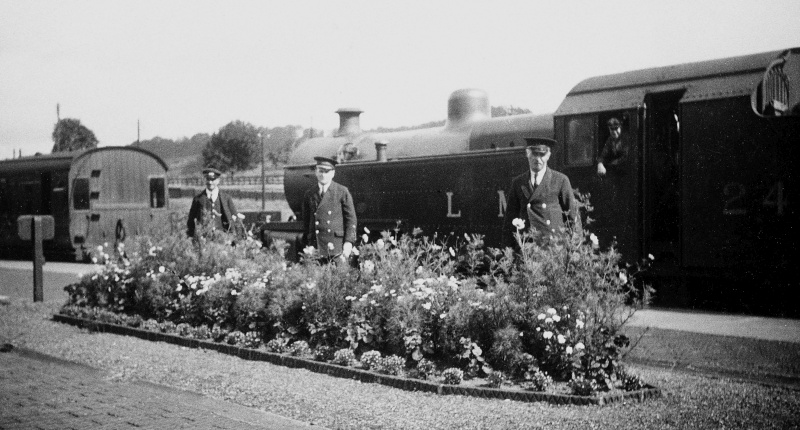
|
Above: from the days when
railway company staff took pride in the appearance
of their station. Tring’s
Station Master and his assistants pose proudly
behind their nicely planted flower bed, the driver
of a local service Fowler 2-6-4T looking on.
Below: up express passing
through Tring Station behind a Bowen Cooke
Claughton. |
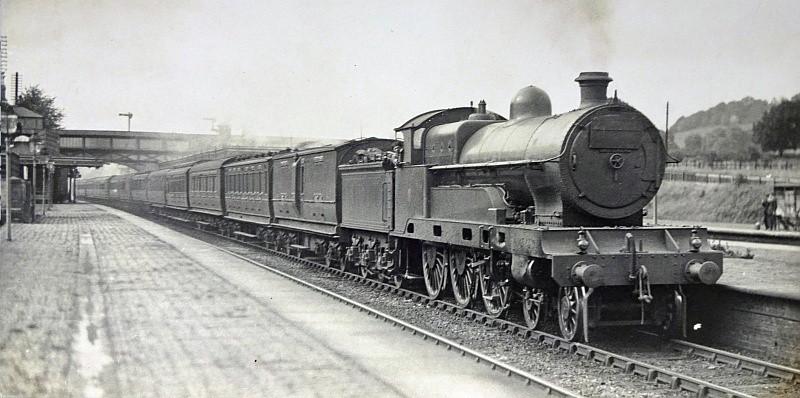
THE AREA AROUND TRING STATION
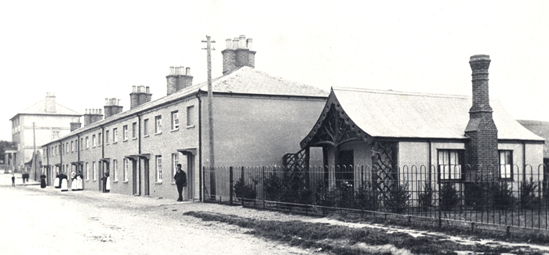
Late Victorian view of the the Royal Hotel,
Railway Cottages, and the original Mission Hall.
Due to its relative isolation, the Company was obliged to provide
accommodation for the station staff, and, in 1841, they built a row
of eleven cottages at a cost of £1,286. Sited adjacent to the
station and fronting the newly built Station Road, they were
numbered 274-284 from Euston. Rents were reasonable at 2s.6d. and
3s.6d. a week, to which parish council rates amounted to a further
5s half-yearly. Shortly afterwards, a substantial Station Master’s
house – designed to reflect the importance of his position -- was
built overlooking the forecourt.
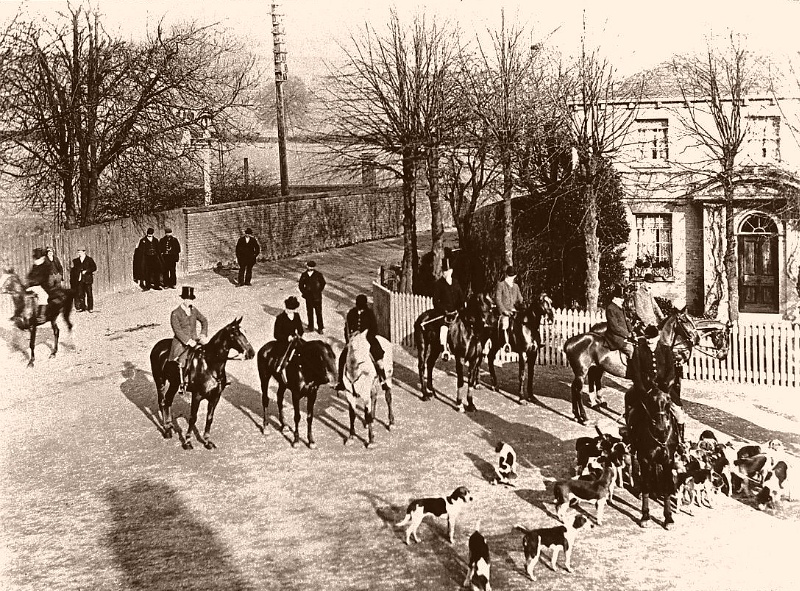
In this scene, the
Station Master’s
house is on the right, the road to Aldbury on the left.
Towards the end of the Victorian
era, the Company (by then the London and North-Western Railway)
built further cottages in a lane overlooking the railway, while the
spiritual needs of the workers were accommodated by the provision of
a metal pre-fabricated Mission Hall; this was later replaced
by the larger structure known today as the Iron Room. The
original mission hall was moved to Puttenham, where it remains.
|
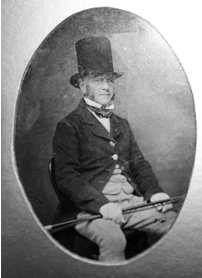 |
|
John Brown (1795-1890), from a
daguerreotype under glass. |
On national census night in 1841, 20 men in the Company’s employment
were recorded living in the area of Tring station. Most lived in the
station cottages, three were staying at the Harcourt Arms and
six lived at Tring Grove. They included four locally-born labourers,
the better-paid skilled jobs being filled by incomers to the area,
including two from Scotland. Among the occupations listed -- and
confirmed by Wishaw’s description above -- are three porters, four
policemen (whose responsibilities included operating signals and
points), an inspector (of railway police), a collector (of
tickets), an engineer (operator of the stationary steam engine
supplying water), and two station clerks. It seems that staff
turnover was quite high, for ten years later only two of the
original 20 remained.
The Company encouraged house-building in the locality of their new
stations, offering incentives in the form of cheaper fairs. Every
ready to take advantage of new business situations, land agent
William Brown placed the following advertisement in The Aylesbury
News & Advertiser in October 1837:
“Contiguous to the London & Birmingham Railway Station, Tring, Herts
―
Mr W. Brown is directed by the Proprietors to submit for public
auction at the Rose & Crown Inn, Tring, on 3rd November 1837 at
three o’clock, in several lots:
Five acres of truly eligible Freehold building ground within a short
distance of the Tring Railway Station, a situation which challenges
comparison on the whole line between London and Birmingham, the
views from it extending an immense distance over the counties of
Herts, Bucks, and Beds, with the advantage of being within and hour
and a half’s ride from London.
Printed particulars of the building ground with a plan attached may
be had in due time at the Auction Mart, London; Kings Arms,
Berkhamsted; Bell, Two Waters; George, Aylesbury; of Mr Faithfull,
Solicitor, Tring; and of Mr W. Brown, Land Surveyor and Auctioneer,
Tring.”
Two years later, William Brown advertised an auction sale
for the mansion and estate owned by William Cooper of Berkhamsted,
the pioneer of veterinary medicine. The advantages for a businessman
or banker to live near to a railway station had by now been
recognised. Following lengthy and glowing details of “the capital and
delightful residence”, the grapery, greenhouse, pleasure
grounds, shrubberies, fishery, and the park of 90 acres, the
description continues: “The situation is singularly desirable,
not only for its interesting views over a picturesque country, but
for its contiguity to the London and Birmingham Railway . . . .”
In his notes, Arthur MacDonald describes how Tring brewer, John
Brown, acquired the land on which to build this large hotel. A
canny, business-like man from Dorset, Brown settled in Tring in 1826
where he purchased the High Street brewery from Thomas Amsden. His
modest fortune was ensured when he seized the opportunity to quench
the drinking needs of the hundreds of navvies engaged in building
the new railway. He built several public houses in the locality,
most in a late-Regency style.
Following the railway’s arrival at Tring, Brown commenced work on
the Harcourt Arms Hotel, placing the work under the
supervision of railway architect George Aitchison. Brown installed
his twin brother as hotel manager and, in March 1839, he was able to
advertise the hotel in The Bucks Herald:
“London and Birmingham Railway – Harcourt Arms Hotel and Posting
House Tring Station. The public are respectfully informed that the
above Hotel is now open for their accommodation, where every
attention will be paid to their comfort and convenience. Horses and
Vehicles always in readiness to convey Passengers from the above
Station, and lock-up Coach Houses.”
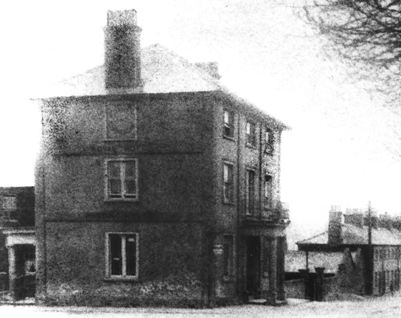
An old
photograph of the Harcourt Arms, later the Royal Hotel.
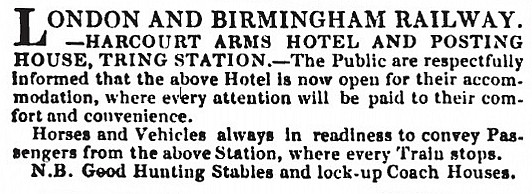
Railway
Times, November 1839
A great sportsman, Brown quickly established the Harcourt Arms
as a centre for hunting activities, and the hotel’s extensive yard
saw many gatherings of local fox and stag hunts in front of its
attractive stable and kennel buildings. The following appeared in
The New Sporting Magazine in 1846:
“. . . . the station of the London and Birmingham Railway at
Euston-grove is a proper introduction to a most proper line, where
they carry you and charge you like a gentleman: your gentry like
good accommodation on good terms. By this rail you reach Tring in an
hour or so, where there is a very excellent hostel, and
cherry-brandy to match — the former the Harcourt Arms. Here Lord
Lonsdale has a considerable stud, and other gentlemen hunting with
the barons [the Rothschilds]
have their horses. His lordship has purchased the White Cross
harriers, whose kennel is in the neighbourhood — at Tring Grove, I
think.”
|
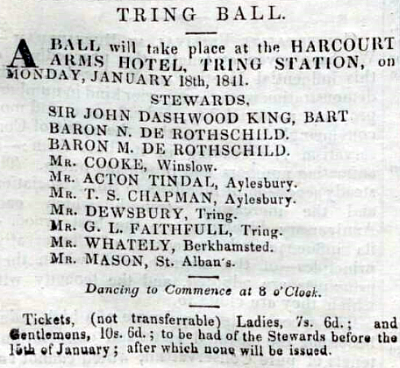 |
|
Bucks Herald,
16th January 1841. |
The White Cross Harriers were not used for what was considered the
noble pastime of hunting carted stags, such as the Rothschilds
promoted, but for the purpose of pursuing ‘bagged foxes’. When his
lordship’s time was limited, the paucity of wild foxes in the
vicinity could mean a wasted day. Accordingly, his foxes (known as
‘bag men’) were housed in cages at the rear of the hotel, stuffed
into a bag when needed, released in the country, and recaptured for
use on another day. This method was despised by purists, and Lord
Lonsdale became the butt of their humour, as these few lines from a
long satirical poem, The Captive Fox, illustrate:
|
“It was an Earl with ancient name,
Who hunted the fox but preferr’d him tame,
Tho’ his sire had been a keen hunter free
And bold as e’er rode o’er a grass countree.
That sire once mounted his well-bred horse,
And view’d the fox from the hillside gorse.
His son has come down by a second-class train,
Worried a bagman and home again. |
There follows a humorous description of the day’s hunting, and ends:
|
So they dug him out, the Earl and his groom,
The Huntsman and Whip, and the man with a broom,
The fox and the hounds are at Tring again,
And his lordship return’d by the four o’clock train.” |
The 1851 census records that the now renamed Royal Hotel had
17 grooms living on the premises, as well as other staff. Some of
the grooms worked as ostlers, for stagecoaches also rumbled in and
stopped under (we are told) the central chestnut tree, where horses
were changed and passengers disembarked to take rest and refreshment
within. The hotel also appears to have boasted a ballroom, as the
advertisement for the Tring Ball proclaims.
THE TRING AGRICULTURAL ASSOCIATION
Arthur MacDonald was keenly interested in all aspects of agriculture
and wrote at length on the subject. The following are some extracts
describing the beginnings of what was first called the ‘Tring Turnip
Show’, to which the Harcourt Arms played host:
“On 20th December 1839, at the Rent dinner of the Harcourt
estate, at the Harcourt Arms, Tring Station, the conversation turned
upon root cultivation, and Mr. Houghton, the Agent for the estate,
gave a challenge which was accepted by Mr. John Brown to show 50 swedes next year for a sovereign.”
|
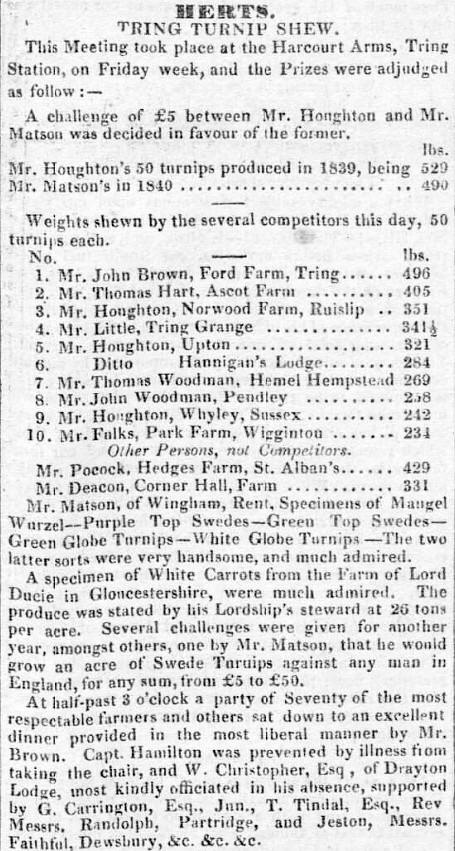 |
|
Bucks Herald,
19th December 1840. |
The competition came off on the 18th December 1840, but John Brown
did not win. However, the event gained some renown and was referred
to as the ‘Tring Turnip Show’, and at the Rent dinner the following
year the idea of a ‘Tring Agricultural Association’ was raised when
one of the gathering made a speech:
“. . . . with regard to the cultivation of the soil, I
consider it of the greatest national importance that we ought not to
stop at trifling improvements, but continue the good work with
increased zeal; by doing which, we might expect in the course of a
few years to see our produce doubled. I consider a new light is
breaking upon us, and my belief is that the science of farming is
now beginning to be known, and I look forward for much benefit from
the various clubs formed and now forming, and more particularly the
Royal Agricultural Society of England . . . .”
The Vicar of Tring, replying to this toast, proposed “That an
association be now formed for the promotion of agriculture and
horticulture, called the Tring Agricultural Association.”
By the time of its first AGM in 1841, the Association was in full
swing. There were classes for corn, in which four bushels of grain
and an average bunch of stalks had to be shown; also for roots. The
winners were required to state at the dinner the kind of soil;
quantity of seed; and method of cultivation of their exhibits. This
gave rise to a discussion on the relative advantages of drilling and
broadcast sowing, and “as to whether a wheat crop will remunerate
the expense of hoeing.” One of the most valuable prizes, £3, was
given to the largest employer of labour on his farm, and there were
classes for cottage garden produce, for long service, and for the
largest family supported in ‘religious and industrious habits with
the least amount of Parochial relief’. Prizes were also awarded for
the best plough and horse hoe.
Two years later the first premiums were offered for stock, and
prizes for the best milch cow and breeding sow were open to
“persons occupying not more than ten acres of land and gaining a
livelihood chiefly thereby, although not members.” There were
also prizes for labourers’ pigs. At this meeting, some experiments
of a startling
kind were described, being no less than the application of
electricity for the stimulation of vegetation. In 1846, we find a
‘Ploughing Match’ announced. In the seed classes, premiums were
offered for White Mustard and for Flax. At the 1846 Dinner, the
president stated that the number of entries had risen from 48 in
1841 to 121 in 1846. He remarked that:
“. . . . one great cause of our success, and of the high
character we have obtained with the public, is that there is more
said here by practical farmers than is generally said at meetings of
this description, and that we lose less time than some do in
bandying compliments with each other at this end of the table.”
The annual agricultural show eventually outgrew the site at Tring
Station and, at the instigation of Lord Rothschild, was moved to
Tring Park where it gained the reputation of being the largest
one-day show in the country.
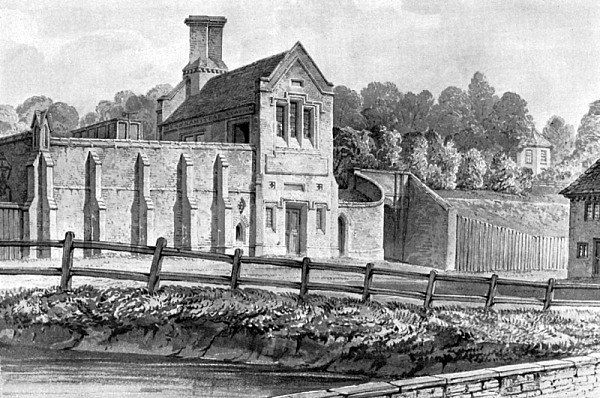
The original Berkhamsted Station stood adjacent to
the Crystal Palace public house.
It was designed in an Elizabethan style with a brick gabled booking
hall.
――――♦――――
STATION ROAD AND ROAD TRANSPORT
A TORTUOUS ROUTE
Prior to 1838, the road from Tring to Pendley and Aldbury was
described by some writers as “a tortuous route.” Following
the arrival of the railway, it soon became apparent that the
popularity of this new form of transport necessitated better
communication between the town and its station. The prospect of a
new road caused one newspaper reporter to lapse into purple prose:
“The inhabitants of Tring have held a meeting at which it
was agreed to form a new road from the town to the station. Mr. Kay
and Captain Harcourt having given the land for that purpose, and the
needed funds raised, buildings are already in progress, and the
inhabitants are making every exertion to accommodate the public that
every day throng this beautiful neighbourhood, which, from the
variety of hill and dale, wood and water, combined with the
extensive views it commands, is likely to become a place of
importance.”
The Bucks Gazette, 28th October 1837.
Arthur MacDonald, in his notes (c.1890) on the subject, was
more down-to-earth and provided a factual description of the
alterations necessary to provide it:
“Station Road. At the east end of the town important
alterations were necessitated by the construction of the railway,
and station in 1838. The traveller by road from Tring to Aldbury
before that date proceeded up the London Road to Dunsley, turned
back across the 3-cornered meadow, following the hedge next the
present cricket ground, to the point where The Laurels now stands,
and which was then the corner of Grove Shrubbery, the latter
extending right round to the fir tree near the recreation ground.
Skirting the shrubbery, as far as Grove Lane, our traveller would
then turn up Cow Lane for a little distance, and strike across what
is now Pendley Park, between the Rookery and a small spinney,
emerging some little distance short of Pendley canal bridge, this
latter part being the ‘Aldbury Road’ mentioned in the Inclosure
Award.
There was also a footpath direct from Dunsley across the farm to the
point in Cow Lane, opposite the ‘Aldbury Road’, continuing across
Pendley Fields (now part of the Park) and the old Pendley Park, to
the Aldbury boundary.
At a Vestry meeting held on 18 Jan. 1838 it was resolved to stop
this footpath and also the portions of the highway to Aldbury
between Dunsley and The Laurels and across Pendley Park, and to
replace them by the new Station Road, which consisted of a new piece
from Tring to The Laurels, a widening of the old road from there to
Grove turn, and another new piece from Grove turn to the Aldbury
boundary near Pendley Farm. The Station Road was opened on the 4th
June 1838. There is no mention in the Vestry minutes of the old road
in continuation of that from Dunsley to The Laurels running to the
fir tree and across the Recreation Ground and Gravel pit field to
Brook Street. This was not stopped, and is still a public road,
though disused. There is also a public road from the London Road at
the bottom of ‘The Twist’ to the Station Road near Grove turn, now
used only for a footpath. Both these were claimed by the Local Board
as public roads on the sale of the Tring Park estate in 1872.”
TRANSPORT TO TRING STATION
|
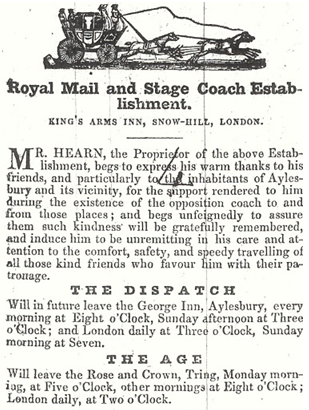 |
|
The Aylesbury News & Bucks
Advertiser, April 1837. |
Proprietors of road transport, whether large businesses offering
services by Royal Mail stagecoach, or small local coach operators,
were understandably worried about the threat of the new ‘iron road’
and its steaming monsters. Until the opening of the line, they took
the opportunity to remind passengers of their past good service, and
to reassure them that this would continue. But as soon as the line
opened, all these concerns quickly adapted to changing circumstances
and started to offer various ways to reach the new station at Tring:
1837: “Thame – Tring Road connection. There are now four
coaches passing through Thame to the railway at Tring, and two more
are shortly to come the same road.”
“A new four-horse coach commenced running on Monday last from Oxford
to the station of the London & Birmingham railway at Tring, and back
daily. It reaches Tring in time for passengers to proceed to London
by the third train, and leaves Tring for Oxford after the third
train arrives from London.”
The Bucks Herald, 4th November 1837.
“The Tring Station on the Birmingham railway is two and
a-quarter-miles from the town, and thirty-one and three-quarters
from Euston Square. Conveyances attend at this Station on the
arrival of several trains, to carry passengers to Tring, Aylesbury,
Oxford etc. Passengers intending to join the trains are desired to
be in good time, as the train leaves each place as soon as
expeditiously as possible. No persons are booked on the railway
after the arrival of the train in the Station.”
Pigot’s Trade Directory 1838 – entry for Tring.
“A Coach from the Plough Inn, Tring, to meet all the trains, and an
Omnibus from the Rose & Crown.
Market Street, Tring: Elizabeth Montague, Post Mistress – Letters
from London arrive (by railway) every afternoon at one and night at
eleven, and are despatched every morning at four and forenoon at
half-past eleven. Letters from the North (by railway) every morning
at half-past five, and at twelve, and are despatched every morning
at three.”
Pigot’s Trade Directory 1839 – entry for Tring.
ROAD WARS
Competition for this new source of business soon caused rivalry to
surface between operators offering road services from Aylesbury to
meet trains to and from the newly-constructed station at “Box Moor,”
as advertisements placed in several Aylesbury newspapers during
August 1837 illustrate:
“Birmingham and London Railway.
(By Appointment).
Joseph Hearn begs respectfully to announce to his friends and
the public generally that he is appointed by the Railway
Committee to book and luggage at his offices; The Kings Arms
Inn, Snowhill and Griffins, Green Man and Still, Oxford Street
where conveyances are appointed to convey passengers and luggage
to the station at Euston Square to meet the departure and
arrival of the whole of the trains from and to Box Moor.
J. H. begs also to announce that his coaches from Tring to
London and from Hemel Hempstead to London are discontinued, and
which, in future will meet the respective trains from Tring at
Box Moor and also from Gaddesden, Ashridge and Hemel Hempstead
at Boxmoor.”
_________________________
“John Elliot, Carrier of Aylesbury: Respectfully informs his
Friends and the Public that he intends conveying Passengers and
Luggage every Monday, Wednesday, and Friday mornings from the
Angel Inn, Aylesbury (where Passengers may secure places) to the
Station House at Box Moor, and that he will start from Aylesbury
at six o’clock each morning, and leave Box Moor at six o’clock
the same evening. Passengers 2s. each extra luggage to be paid
for.”
_________________________
“CHAS. JOHSON,
Bull’s Head Inn, Aylesbury respectfully informs his friends and
the public that he has commenced running an Omnibus from
Aylesbury to Box Moor, and back, daily.
The Omnibus leaves the Bull’s Head Inn every Monday morning at a
quarter after five, other mornings at a quarter to six, so as to
enable passengers to go by the FIRST TRAIN
to London; and leaves Box Moor for Aylesbury every evening at
half-past six and arrives there at half-past eight.
In starting this Omnibus C. J. deemed himself justified by the
fact that there was no conveyance direct to the Railroad, and
that, therefore, those parties who desired to proceed to London
by the trains were put to great inconvenience; he had no
intention of injuring any individual, but was merely desirous of
affording the public that accommodation of which they stood in
need. No sooner, however, was the notice given that he intended
starting his Omnibus than Mr. Hearn made arrangements for
opposing him by starting a coach from Aylesbury at the same
time, to carry passengers at whatever price he could get; his
sole object being to drive the Omnibus off the road, in order
that the public may again experience that want of accommodation
which induced the proprietor to start it, and be again at the
mercy of Mr. Hearn’s high charges. Unable individually to
compete with this great monopolist, C. J. places his case in the
hands of the public, assuring them that so long as he is
properly supported – so long, indeed, as the expenses are
covered – the Omnibus shall continue to run, despite all the
opposition that Mr. Hearn may bring against it. Passengers
2s.6d. each.”
In October 37, the railway reached Tring and the road operators
changed their destination accordingly (for ‘Pendley Station’
read ‘Tring’):
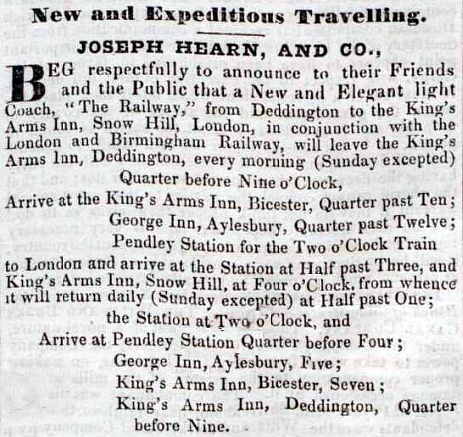
Bucks Herald, 11th November 1837.
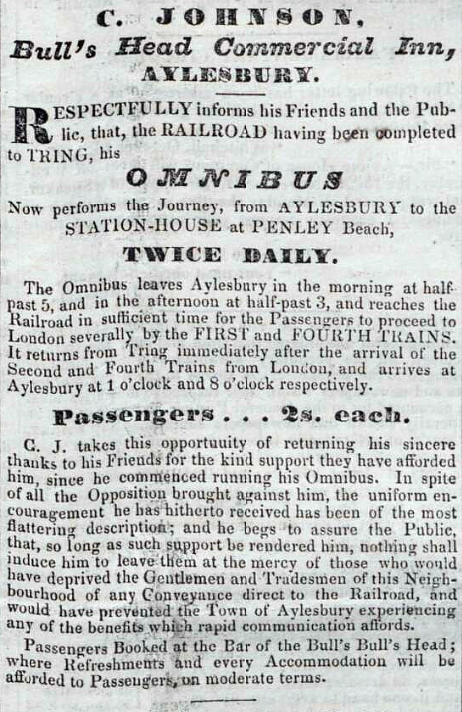
The Bucks Herald,
21st October 1837.
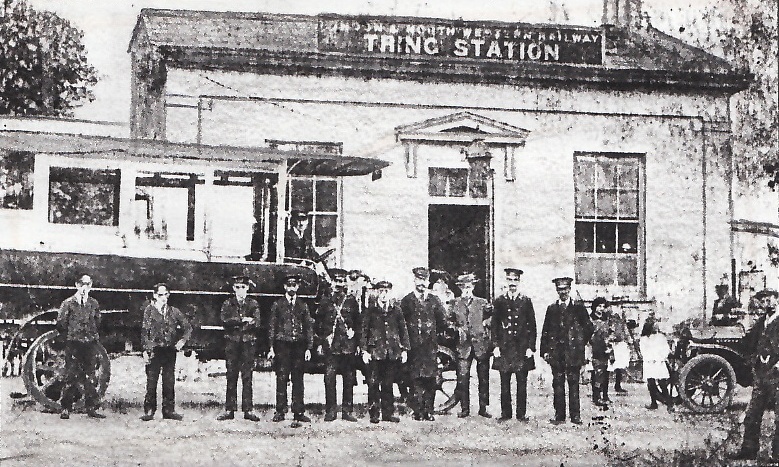
Tring’s
first petrol-powered station omnibus, 1914.
On the 10th June 1839, the world’s first ‘branch’ railway opened,
connecting Aylesbury with the London and Birmingham Railway at
Cheddington. Engineered by Robert Stephenson, the Bucks Herald’s
reporter confidently predicted that “if the pleasure and success
of the day may be taken as a type of the future prosperity of this
undertaking, it will be amongst the most thriving of the
Railroads in the kingdom.” That optimistic prediction didn’t
come to pass – the line closed to passengers in February 1953 – but
for many years the citizens of Aylesbury did have a railway
connection to the wider world. How the competing coaching operators
fared is another story.
――――♦―――― |
|
ACCIDENTS AND INCIDENTS
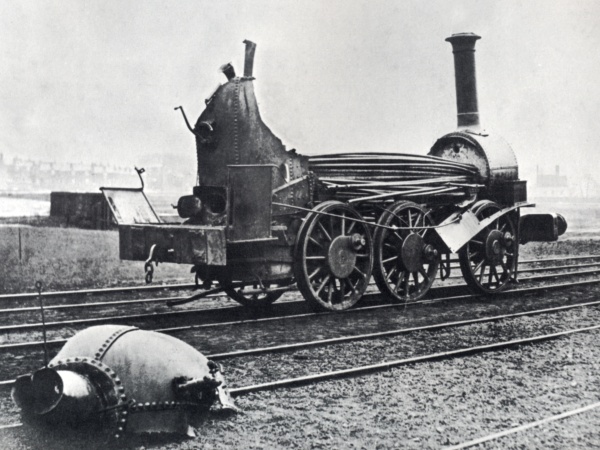
Aftermath of a locomotive boiler explosion c.
1850.
Location and circumstances unknown.
Early civil engineering projects often incurred fatal accidents, and
the construction of the London and Birmingham Railway was no
exception. Examples have been given of tunnel
accidents at Northchurch and
Watford. Rather surprisingly, only one
death is recorded during the construction of the Tring cutting, and
seven altogether along the Tring section of the line, plus various
injuries (but in an age when amputation was sometimes the only means
of dealing with fractures). The newspapers of the time took ghoulish
delight in printing the details of any accident with a gory outcome:
“Shocking accident . . . . a poor
fellow, Joseph Hill, met with his death in the following awful
manner. He, in company with several other labourers, was felling a
tree upon that part of the London and Birmingham railway which is
near the village of Two Waters, when, happening to stand under the
tree at its falling. The poor fellow’s head was literally smashed,
his brains scattered about in all directions . . . .”
The Aylesbury News & Bucks
Advertiser, 1st April 1837.
A new hospital was opened at Cheere House, Hemel Hempstead,
in 1832. It was recorded that between July 1836 and July 1837, 43
railway accident patients were admitted, six of which were fatal. At
first, the Directors of the railway gave a donation of £21, but as
the number of accidents increased they agreed to pay 8s. a week for
any employee sent to the hospital. Cubitts, the contractors of the
stretch of the line from Kings Langley to the northern end of
Northchurch Tunnel, made the same
arrangement. The Governors were so shocked by the “numerous and
dreadful cases” that they recommended to the employers concerned
that a ganger or some intelligent workman be instructed in applying
a temporary tourniquet. The hospital also did a brisk trade in the
supply of trusses. Cases were transported to the hospital along the
new line and then onwards by cart.

Cheere House, West Herts Infirmary,
opened in
1832 at a cost of £13,000.
Once sections of the new railway were in use, accidents
continued on the operational railway due to locomotive boiler
explosions, mechanical failures, run-away trains, railwaymen being crushed underneath or
between wagons, and through other circumstances including what today might
be described as ‘operator error’:
“Accident on the Railway – on Saturday,
a man employed on the railway, in attempting to get into a wagon at
Berkhamsted, while the train was going on, unhappily fell and
several wagons went over him, by which he was so dreadfully crushed
that he died the same night in the West Herts Infirmary.
On Tuesday following, another man was killed on the spot, near Box
Moor, by a piece of timber falling on him; and on Wednesday another
labourer had his legs fractured on the railway near Northchurch.”
Aylesbury News & Bucks Advertiser,
8th April 1837.
“On
Saturday last about one o'clock, as a long train of ballast waggons
was proceeding along the line towards Two Waters, another train was
coming down, when the former one stopped to let the other pass.
The waggons, in starting again, suddenly threw a man off, named
William Tomkins, who lived at Tring, and eight waggons passed over
the unfortunate man’s neck,
which severed the head from his body.”
Bucks Herald, 7th September
1839.
“George Hodgkinson, aged 30 years, expired at the Middlesex Hospital
in consequence of an accident which befell him on the London and
Birmingham Railway. The deceased was a stoker, and whilst proceeding
through Tring overtook a luggage train that had started an hour
previously but had been detained from some defect in the machinery. The deceased and his brother, fearing a collision, jumped off the
engine, when one of the up trains was passing at the time, the step
of one of the carriages struck him on the right thigh, and threw him
with great force on his face, and when raised up the limb was found
to be severed. He was conveyed to hospital, where, after amputation,
he died.”
The Yorkshire Gazette, 21st
September 1839.
“The
train which left Aylesbury for London at 11 o’clock on
Thursday morning, consisting of a second class carriage next to the
tender, two first class carriages, and another second class carriage
at the end, was passing over the embankment, about three quarters of
a mile north of the Northchurch Tunnel, when the fore-wheel of the
ending was suddenly separated from it by the breaking of the fore
axle (which is four inches and a half thick) between the journal and
the wheel. The engine and tender were in consequence thrown
over the near side of the embankment, which is about 15 feet high,
and the leading second class carriage over the off side. The
other carriages remained on the road. The engine-driver
escaped without injury ― his assistant was considerably hurt ― and
three passengers, who were in the second class carriage, which was
overturned, also received severe, though, it is hoped, not fatal
injuries. The following is the official report of the surgeon
who attended on behalf of the Company. The names of the
persons who were injured by the accident at Northchurch, Dec. 8th,
1842:―
John Tomlin, of Boxmoor ― severe injury to the head and fracture of
ribs.
Mary Bye, of Aylesbury ― severe injury to the head.
John Pemberton, Company’s stoker, concussion of the brain.
Matthew Lowe, overlooker, Berkhamstead ― injury to the back.
On an examination of the fractured axle, it appears that the iron,
with the exception of a very small portion, is defective, although
not externally apparent, and that the separation is so close to the
wheel, that at first view it would seem to have been made by a
knife. The circumstances of the accident will be fully reported to
the Board of Trade for investigation by General Pasley.”
Yorkshire Gazette, 10th December
1842.
“Shortly before four o'clock on Tuesday
afternoon an accident of a serious character, but happily not
attended with any fatal consequences, occurred on the London and
North-Western Railway, near Tring, through, it is believed, the
carelessness of the engine-driver who had charge of the train.
It appears that when the passenger train, which started from London
at forty-five minutes past two on the above afternoon, arrived near
the Tring station, the engine-driver not regarding the signal which
was hoisted to caution him of danger, ran into a luggage train.
In an instant the utmost confusion ensued. The luggage train
being heavily laden, and the passenger train being a long one, the
shock was of a very violent nature. Upon examining the
passengers, it was found that several had received severe contusions
on various parts of the head and body, and that two persons were
very seriously injured. They were immediately attended to by a
medical gentleman, and they are now in a fair way of recovery.
The engine-driver having been questioned as to why he did not attend
to the signal, gave such unsatisfactory replies that he was given
into custody. The train was delayed for upwards of two hours.”
Herts Mercury, 24th July 1847.
The Windsor and Eton Express blamed the same incident on
“the negligence of the policeman in placing the switches
[i.e. points]” and goes on to say that poor
Hodginson’s leg was “torn and mutilated in a most fright manner”.
But train accident casualties were not always human, as the
Worcester Journal of 8th November 1838 reported; two
cattle trains came into collision on the line near Tring, and
several of the animals “were much injured”. Apart from human
error, officialdom was sometimes blamed for such misfortunes, and
comments from newspaper editors were not uncommon. This from The
Bucks Gazette, October 1837:
“We regret to notice a considerable
disregard with respect to the lives of persons employed on the
different railways; and a most particular instance of such apathy
has been presented in the narrative of the mail-guard being flung
from his seat by the shock, we believe, of an opposite train . . . .
It appears to us that the accident which took place is solely
attributable to the directors, who must undoubtedly ought to take
care that a seat should be reserved for the guard inside the vehicle
. . . .”
Although many accidents recorded during the days of the London
and Birmingham Railway were fatal, fortunately – perhaps luckily –
not all were so:
“There was an accident to the Tring
train at Northchurch. The axle of the train broke, and the engine
ran down the embankment.”
Tring Vestry Minutes, 8th
December 1842.
“Collision on the Birmingham Railway – On Saturday evening the up
mixed train, met with an accident of a formidable nature, but which
did not, fortunately, cause loss of life or limb to anyone. Everything went on well until the train passed the Cheddington
station, but on entering a deep cutting about two miles from Tring,
the train came in violent collision with three luggage waggons,
which were most unaccountably left standing on the rails. Most of
the passengers were thrown off their seats, and as soon as they
recovered from the shock, many of them got out and scrambled up the
cutting, as there was great fear of the express train coming up and
dashing the other train to pieces. The guards, however, immediately
despatched men both up and down the line with signals to stop it,
and in this they fortunately succeeded. The three waggons were
turned off the rails, the first one completely thrown over, and all
of them much damaged by the collision . . . .”
The Times, 23rd March 1846.
“The luggage train from Aylesbury ran off with the gates at the
level crossing at (Long) Marston Gate. The gate-keeper had gone to
sleep, and neglected to open them, so the train went through and
took them right away.”
Tring Vestry Minutes, 10th
August 1846.
Other than railway accidents, there were also incidents
connected with the railway:
“On Saturday last, about a quarter
before seven, as the Aylesbury omnibus (which conveys passengers to
and from Box Moor railway station) was descending the hill at the
beginning of Market Street, Tring, at a rather rapid rate, it so
overpowered the horses that the driver lost his command over them
and it ran with a fearful crash against the premises of Mr. Putnam,
baker, and drove one side of the windows completely out, and
shattered the glass in all directions, broke the pole and otherwise
injured the omnibus; but we are glad to state that the passengers
escaped without injury except for being much frightened. They
proceeded without delay, in a carriage lent by Mr. Northwood of the
Rose & Crown Inn.”
The Bucks Gazette, 8th July 1837.
“It is lamentable to contemplate that the various railways now in
progress – works calculated to improve the condition of all classes,
and to exhibit the wondrous effects of enterprise and industry, are
on the other hand so productive of evil from the irregularities and
crimes of the labourers employed thereon . . . . it appears that the
ample wages received by these labourers enable them to congregate at
beer-houses and drink to excess, and to concoct plans of outrage so
as to render the vicinity of those places where they are employed
dangerous in the extreme . . . .”
The Bucks Gazette, 21st
October 1837.
This rant continues in the same vein for several more
paragraphs, but the writer seems to have a point; this from the
Hertfordshire Mercury, April 1835:
“James Howe, James Carrott, Charles
Robinson and Joshua Harrowell were charged with stealing some beer,
the property of George Garratt. The prisoners were employed as
labourers on the works of the London and Birmingham Railway at
Tring. It appeared by the evidence that Mr. Garratt, of Little
Gaddesden, was in the practice of sending beer in a cart to the
works to sell to the men, and that on the 10th March the prisoners,
and some other of the men, got round the cart, pulled the casks out,
and drank the beer from out of them; they refused to pay for the
beer. It did not appear that Howe was engaged in the beginning of
the affair, which altogether had the character of a drunken row. –
The jury acquitted Howe, and found the other prisoners Guilty. They
were sentenced to one week’s imprisonment.”
A different sort of incident occurred at Tring in November 1838,
which caused an indignant rumpus reported in papers all over the
country. Interest was aroused because it involved a distinguished
person in the shape of Sir Henry Halford, President of the College
of Physicians, who was travelling to London accompanied by a friend,
a Mr Lockley. It seems that the latter gentleman, having suffered
some manner of seizure during the journey, was hastily deposited at
Tring Station by Sir Henry who then proceeded on his way. He was
greatly criticised for this seemingly unfeeling action, The
Examiner probed the affair thoroughly using some
investigative journalism:
“. . . . Let the profession and the
public hear the plain and naked truth. The evidence which we have to
offer has been received from the lips of the persons, who really did
discharge, with care and benevolence, the obligations of humanity on
that trying occasion . . . . Is it true, then, that Sir Henry Halford ‘took Mr Lockley out of the carriage, and carried him into
the inspector’s parlour?’ Is it true that he even saw either of
these things done? No, is the reply; and, incredible as it may
appear, the officers of the railways who took the all but lifeless
body of Mr. Lockley from the carriage, did not even conjecture that
the President of the College of Physicians was the ‘friend’ or even
an acquaintance of the object of their solicitude! What then did
really happen at the station?
. . . . the train having arrived, the officers were beckoned to one
of the carriages, and thus accosted by a venerable-looking personage
within . . . . Did this ‘friend’ even get out of the carriage? He
did not, but, frightful to relate, actually flew off with the train,
leaving his senseless and speechless friend in the open road,
supported in a chair placed on the cold clay by the hands of
official strangers.
In closing our notice of this distressing subject, we feel it to be
our duty to state that Mr. Lockley was treated with marked humanity
and attention by the officers of the railway who conduct the
business of the station. Tring, it should be know is situated at a
distance of two miles from that place, and even the aid of Mr.
Dewsbury’s [the doctor at Tring] youthful apprentice was not
obtained until Mr. Lockley had been moved to Tring, over a rough
road in an omnibus. He was conducted thither and held up in his seat
by one of the chief officers of the station and four subordinates of
that establishment. He was put into a bed at the Rose and Crown
Tavern, a respectable and well-conducted house, where he received
every attention which a kind solicitude could bestow. He had
property in his pockets of the value of upwards of 60 pounds, of
which an inventory was taken by the collector of the station and his
name and address were found on a card discovered in his pocket.”
It is unsurprising that very soon after his ordeal,
Mr. Lockley expired, and although Sir Henry robustly defended his
actions the newspapers continued to heap opprobrium upon him.
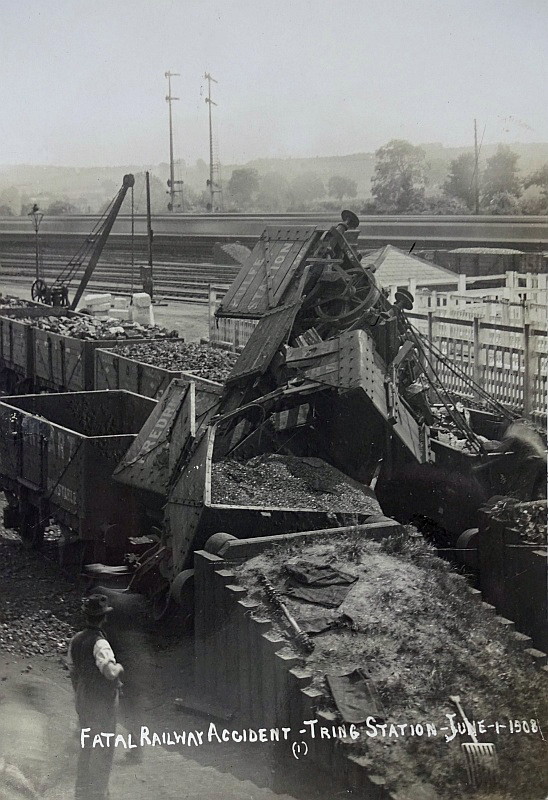
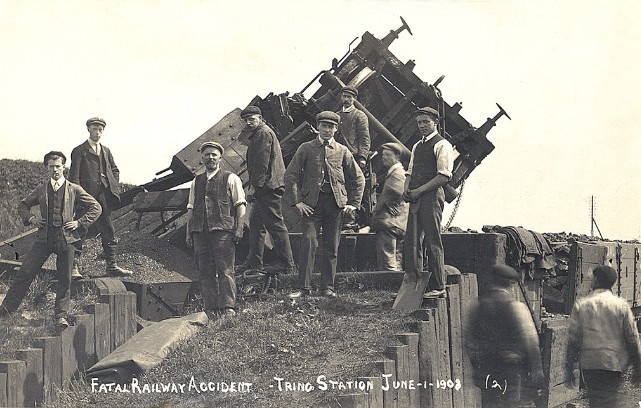
“Fatal accident at Tring Station: On
Monday morning, while some coal trucks were being shunted on to a
siding at Tring Station, owing to the points being wrongly set the
trucks ran into the coal yard and dashed violently into some trucks
which were being unloaded. The force of the collision drove some of
the trucks up on to those which were standing in the yard, and
smashed and overturned others. A lad named Higby, who was on one of
the trucks, got wedged between the buffers of one truck and the
bottom of another which was upturned. He was frightfully mangled,
and killed outright. Another lad, named Butler, was seriously
injured . . . . John Higby, of harrow-yard, Tring, father of
deceased, said his son was a general labourer. He was 17 years of
age, and lived at home. He had been of rather weak intellect from
his birth. He was waiting at the station, as he usually did, to help
load the coal. He held the sacks for the men while they put the coal
in.”
The Bucks Herald, 6th June 1908.
――――♦―――― |
IN MEMORY OF WILLIAM P. McCOWELL
Station Master at Tring, 1842-1863
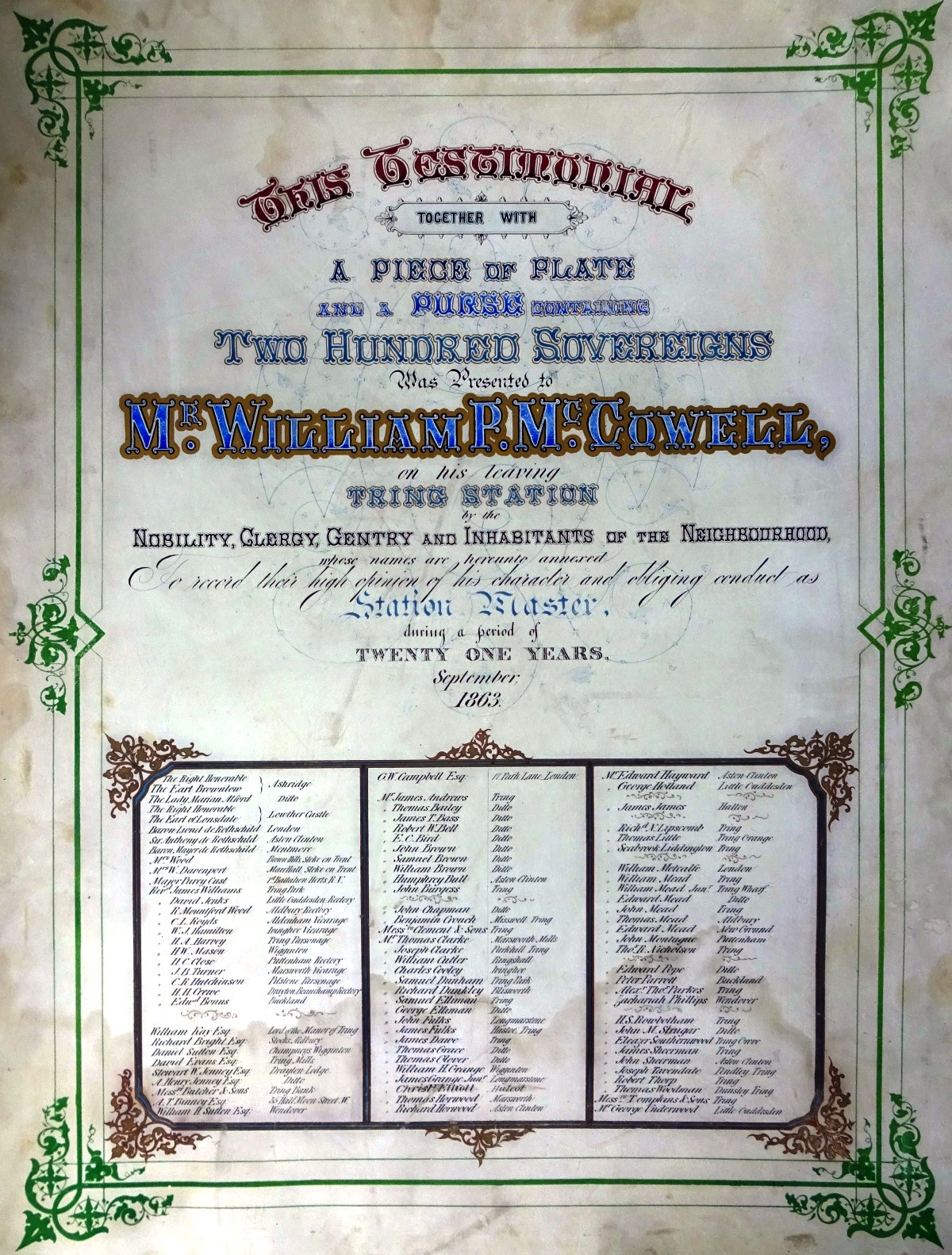
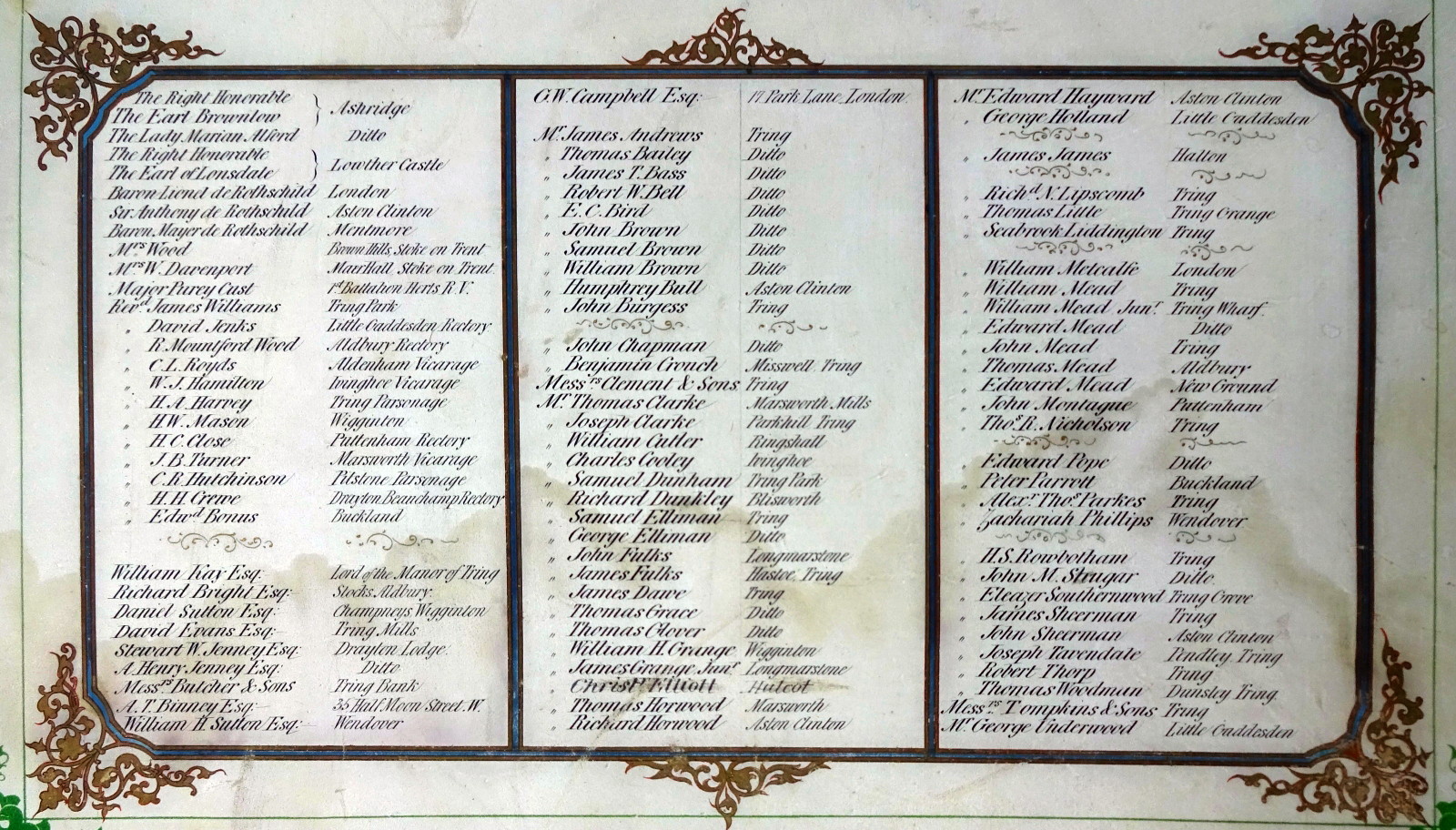
|
AFTERWORD
In 1846, the London and Birmingham Railway Company merged with the
Grand Junction and the Manchester and Birmingham railway companies
to form the London and North Western Railway. By the late 19th
century the L&NWR had grown into the largest joint stock company in
the world. However, the great pressure placed on our railway network
during World War I. together with little opportunity or resources
for proper maintenance left it in a sorry condition, and, when peace
returned, it was losing money. The government of
the day aimed to remedy the situation by imposing a merger on most of
the 120 railway companies then existing . . . .
“With a view to the reorganisation and more
efficient and economical working of the railway system of Great
Britain railways shall be formed into groups in accordance with the
provisions of this Act, and the principal railway companies in each
group shall be amalgamated, and other companies absorbed in a manner
provided by this Act.”
From The Railways Act 1921.
In 1923, in what became known as the ‘grouping’, four large railway
companies were formed from this merger, the L&NWR becoming a
constituent of the London, Midland and Scottish Railway (LMS), the
direct ancestor of today’s West Coast Main Line. During the
inter-war years competition from road transport intensified, while a
further lack of maintenance during World War II. again left our
railway system in a very run-down condition. In 1947, under Clement Atlee’s
Transport Act, the majority of the U.K.’s railways were nationalised
(together with road
transport, waterways and docks, all coming under the unwieldy
‘British Transport Commission’) to form ‘British Railways’. Although from the
travelling public’s point of view controversial, British Railways
did set about modernising our railway network by pruning the deadwood, perhaps excessively! The first section of the West Coast
Main Line to be electrified – from Crewe to Manchester – was completed in September
1960 to be followed in March 1967 by the southern section
corresponding to the former London to Birmingham Railway.
Were he to return, Robert Stephenson would find very little
resemblance between today’s railway and that which he built. Although much of the
original civil engineering remains it is festooned with
high-tension cables and associated paraphernalia, tampered with by trackbed widening schemes and often obscured by modern development. Another very noticeable change would be to the size and speed of the
rolling stock, made possible in part by the heavy gauge, continuous
welded steel rail, laid on pre-stressed concrete sleepers in a bed
of crushed granite ballast. Likewise, colour light signals have
replaced the top-hatted ‘policeman’ with their flags and signal
lamps, stationed in the open at points along the line. The changes
that have been made to station architecture would astonish and
probably appal him – one wonders what he would make of today’s
utilitarian but æsthetically deprived termini! Almost none of the
Railway’s original station architecture remains, its intermediate
stations having being rebuilt (and sometimes relocated) within a few
years of its opening. As a coup-de-grâce, the remnants of
its two great termini, at Euston and at New Street, succumbed to the
architectural vandalism of the 1960s. |

Top: Euston Station in 1838, by John Cooke Bourne. Below: Birmingham New Street Station c. 1855, Illustrated London News.
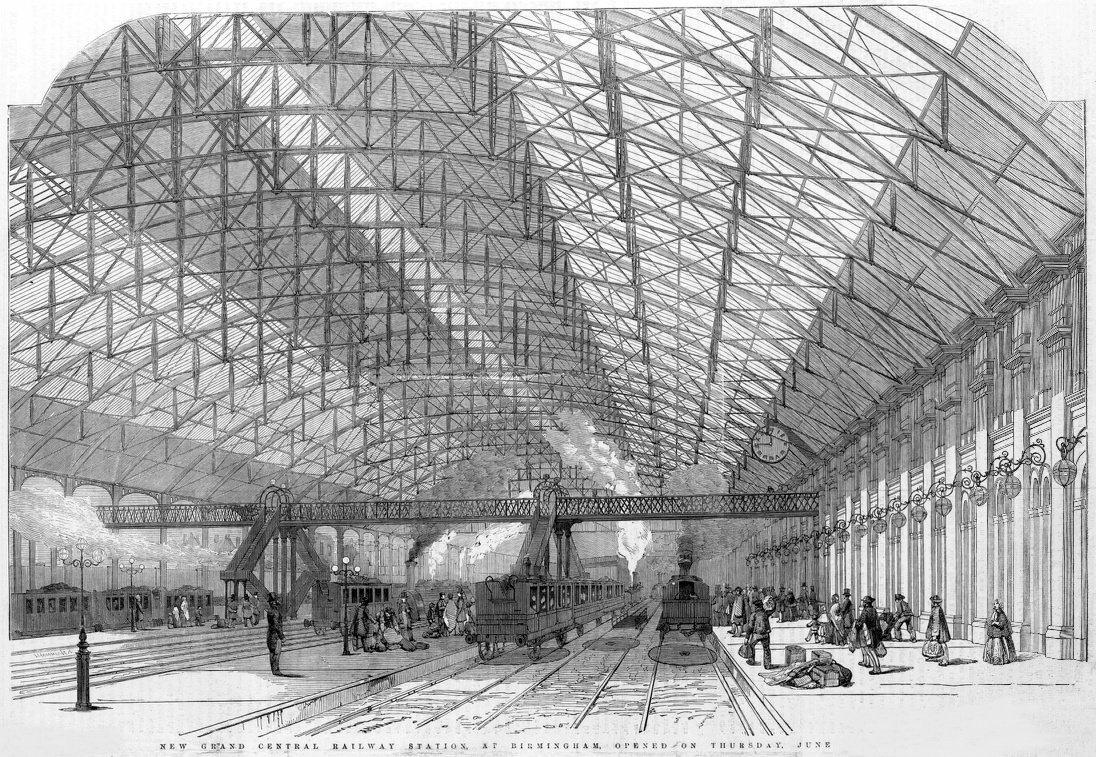
|
At Tring, the railway has seen many changes over the years. The
track-bed has twice been widened, first to accommodate three tracks
(1859) and then four (1876), extensive goods
sidings have been built and then replaced by car parks, station
buildings have come and gone (together with their public
conveniences), and the Railway has been electrified. But a few reminders of the old London and Birmingham
days remain; the long straight road leading to the Town, the row of
station cottages at its eastern end, and, perhaps, the only true
survivor, the Royal Hotel (now converted to apartments).
――――♦――――
ANNEX
Riotous behaviour among the railway navvies.
Depositions of Samuel Williams, who says that on the 25th instant
from between seven and eight in the morning until six o'clock in the
evening, as certain Irishmen were passing through the town of
Berkhampstead they were attacked by parties of the labourers working
on the London and Birmingham Railway who set dogs upon them. About
six o'clock on that evening he saw a party of Irishmen about twelve
in number passing through the town, and when opposite to a beershop
kept by Mary Foster which is opposite to deponent's house he saw a
number of labourers (seven or eight) come out of that house and
attack the Irishmen. They first hooted at them and struck them with
their fists, and as the Irishman ran away they threw stones at them
and set two dogs at them which appeared to tear them. The prisoner,
William Stubbs, was one of the labourers who came out of the
beershop and appeared to be the leader of the gang. The Irishmen
were very much exasperated and came back when the labourers
retreated into the house, and several inhabitants of the town
assembled and took Stubbs into custody. A large number of railway
labourers assembled on the occasion and there was a great riot in
the town.
William Morris bears out the above statement and says the Irishmen
were knocked down, beaten, and kicked unmercifully; Samuel Williams
bears testimony to the above likewise and was present at the taking
of the prisoners.
27th July, 1836.
_____________________
Joseph Elliott, constable, of Hemel Hempstead, deposes that in
obedience to a warrant he apprehended Joseph Adams on 21st of August
last. Whilst conveying him to detention in his cart he was stopped
by twenty or thirty labourers, some armed with great flints and
others with spades, and they threw at him and threatened to kill his
horse and himself if be did not liberate the prisoner. Two of the
men then pulled out their knives to kill the horse. Whilst they were
round the deponent the prisoner Adams jumped out of the cart and
made his escape. Deponent went after him but could not find him
again until the following Sunday when he took him in his own house.
Deponent does not know any of the men who rescued the prisoner.
6th September.
_____________________
Information of John Hughes, sub-contractor of the railway, residing
at Box Moor, in the parish of Hemel Hempstead, concerning Joseph
Adams, charged with a riot. The said John Hughes states that on the
21st of August last he did let some work on the line of the railway
at Box Moor to some men of the county who were working there about
six o'clock on that morning, when they were attacked by some men who
he had also employed the week before, but who had been discharged on
the Saturday night on account of their refusing to work by the
piece. Those who continued to work by the piece, about 30 or 40 in
number, went there for the purpose of working on the Monday morning,
the 21st August, when they were attacked by those who would not work
by the piece, numbering 40 or 50, who pelted them with chalk, and
hooted at them and abused them and drove them from their work. Their
desire was to prevent the workers from working by the piece, and
compel them to return to work by the day. The workers were thus
obliged to leave their work until informant had been to a magistrate
and obtained the assistance of a peace officer. The party persisted
in attacks for an hour and upwards, and the prisoner, Joseph Adams,
appeared to be one of the ring-leaders. Thomas Greenhill,
superintendent on the railway at Boxmoor, confirms the above
statement.
6th September.
――――♦――――
MAIN SOURCES
Osborne’s Railway Guide, 1840.
Wishaw’s Railway Guide, 1842.
Notes from the History of Tring, Arthur MacDonald (Brown),
c.1890.
Tring Vestry Minutes, 1835-1848.
History of the Railway connecting London and Birmingham, Lt.
Peter Lecount R.N., F.R.A.S., C.E.
George and Robert Stephenson, Michael Robbins, pub. 1966.
Extracts from the correspondence of Robert Stephenson.
Archive copies of
The Times, The Aylesbury News & Bucks Advertiser, The Bucks Gazette,
and The Bucks Herald, and other daily and local newspapers.
OTHER SOURCES
A History of the London & Birmingham Railway, Vol.1, London to
Bletchley, Peter Richards and Bill Simpson, pub. 2004.
History of Hemel Hempstead, Susan Yaxley, pub.1973.
Railroadiana, pub.1838.
Tring Gardens, Wendy Austin, pub. 2006.
Railways of Dacorum, catalogue to accompany exhibition 2000, C.
J. Goldsworthy.
The Mechanics’ Magazine, Vol.23, 1835.
Tring and the Railway, Hertfordshire Past and Present, No.19,
article by Peter S Richards, Spring 2012.
The New Sporting Magazine, 1846.
Pigot’s Trade Directories.
Census returns for 1841 and 1851, and sources as quoted in the
text.
――――♦――――

<>
|
|